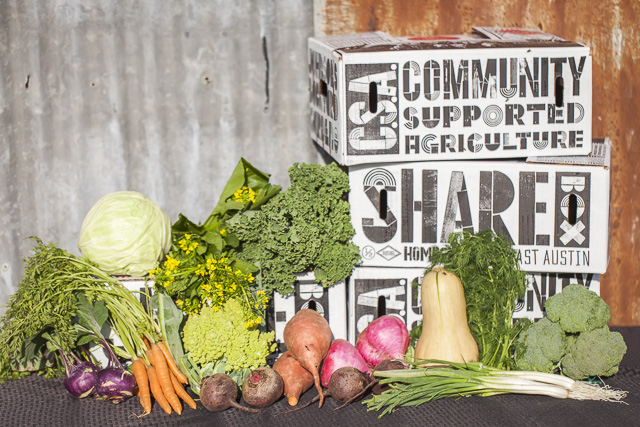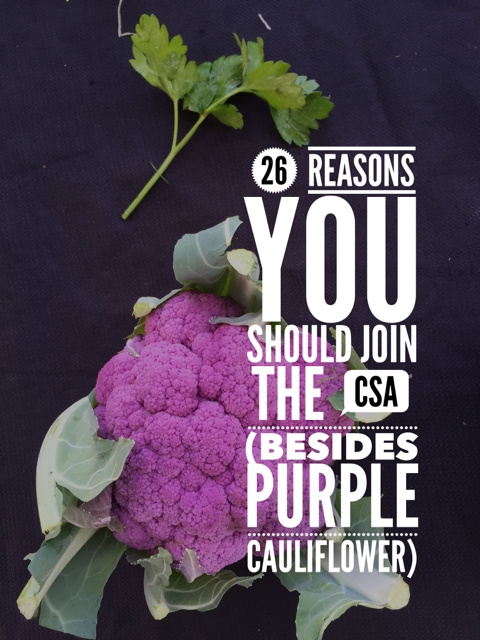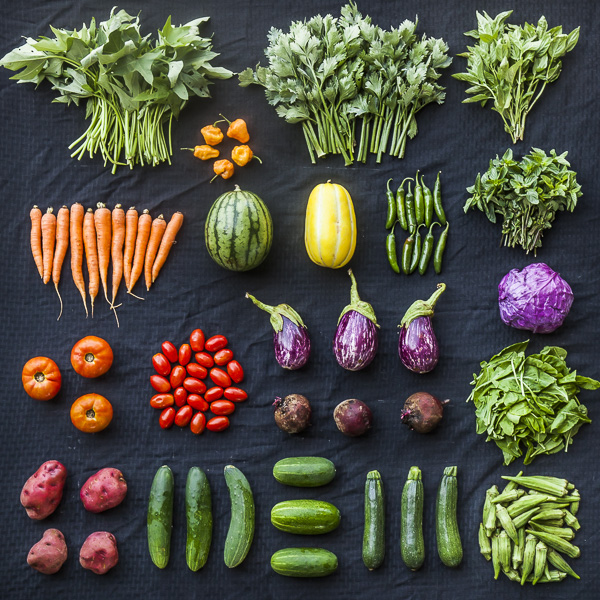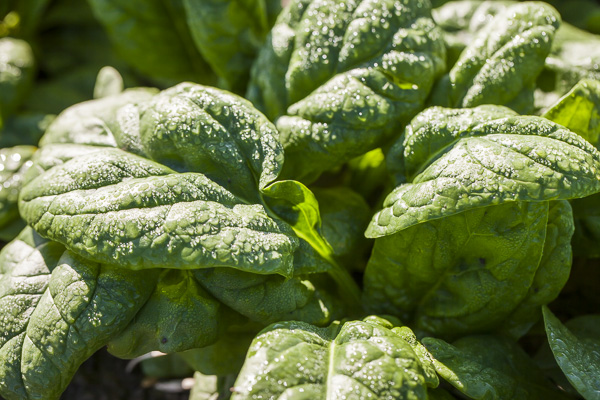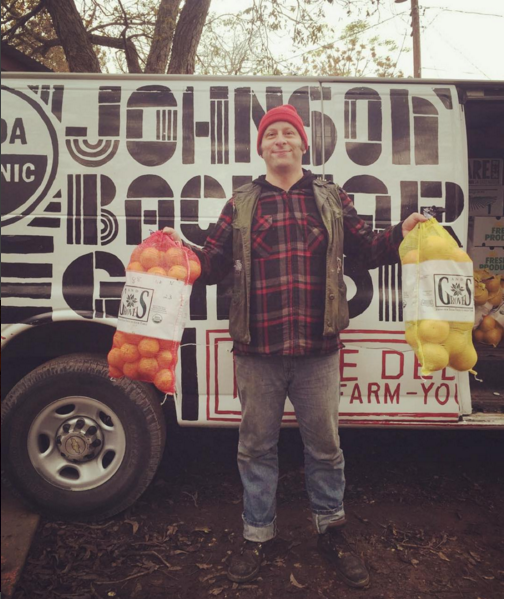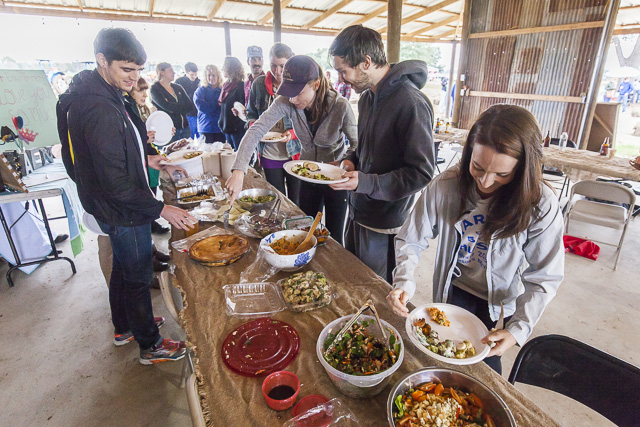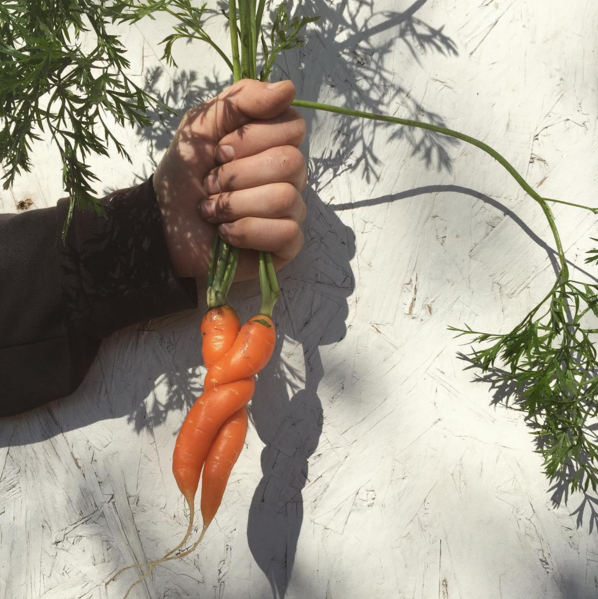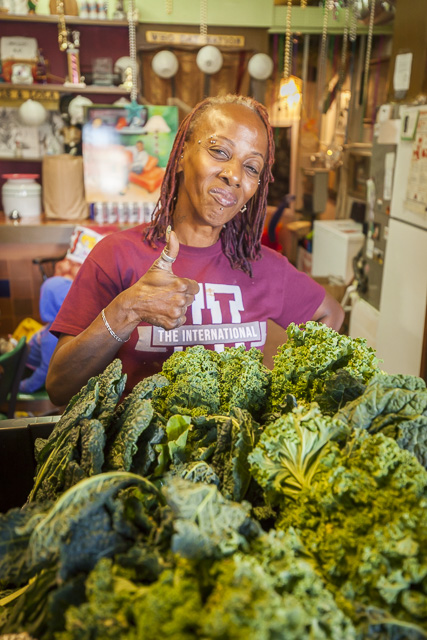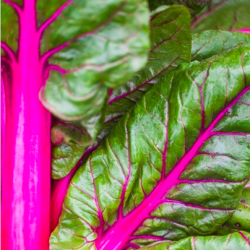
REMINDER! FREE CITRUS FOR THE NEW YEAR...
01/01/16 — Farm
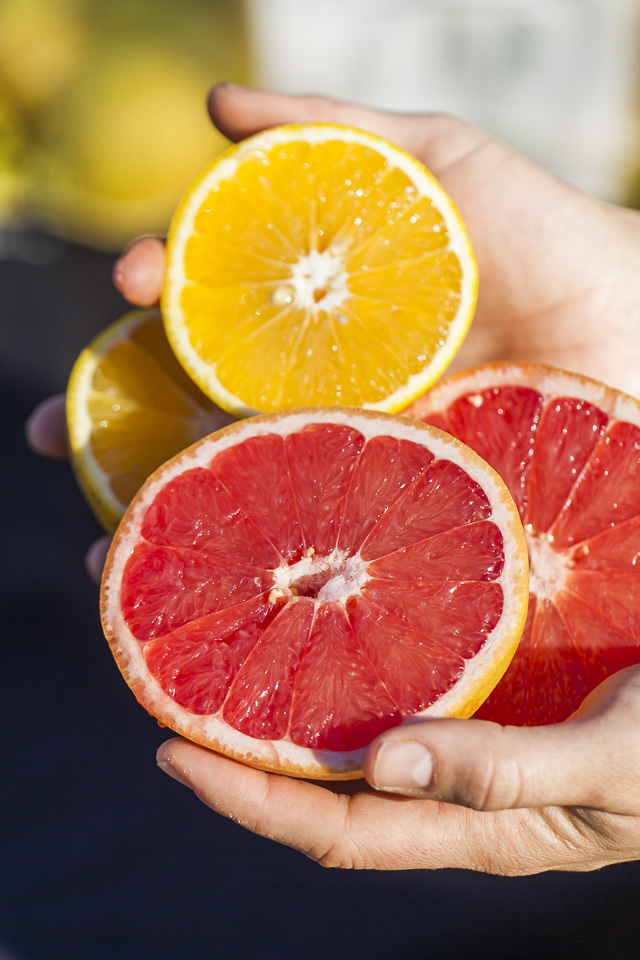
Happy New Year from the farm! Don't forget - we've got some great extras for you when you commit to your health in 2016 by purchasing a CSA share tis January! From now until January 31st, we'd like to thank you for joining our CSA with some yummy organic citrus...
New Members:
Never joined our CSA program? There's never been a better time! Join now and receive a free bag of organic oranges or organic grapefruit with your first delivery. Enter NWYR at checkout.Learn more about our CSA program and join today -- sign-up is an easy online process!
Existing Members:
We are asking existing CSA members if 2016 might be the year you commit to your health, and our farm, by joining as a long-term member. If you love our vegetables and intend to eat them year-round, please consider signing up for a 6 or 12 month subscription. These long-term subscriptions help the farm immensely to pay staff when harvests are slow, and to buy seed at the beginning of each season (just to name a few).If you make this change now, we will send some tokens of our appreciation your way!
- 10% discount for 52-week subscriptions
- 7.5% discount for 26-week subscriptions
- A one-share CSA Gift Subscription to give to a friend, plus a free bag of organic citrus with an upcoming CSA delivery!*
- More than 250 varieties of seasonal, organic vegetables delivered right to your home or neighborhood, year round
- Flexible online management of your CSA schedule - postpone for travel!
- Customizable CSA boxes to ensure you get the veggies you want
- Add-ons to fill your kitchen with good food like local, free-range eggs and local, small batch roasted coffees
Email the farm and Ada or Daniel would love to set up your long-term subscription. *Offer ends January 31st, so strike while the iron is hot!
Happy New Year from all of the folks here at JBG!
2015: THE YEAR IN PHOTOS
01/01/16 — Farm
January:
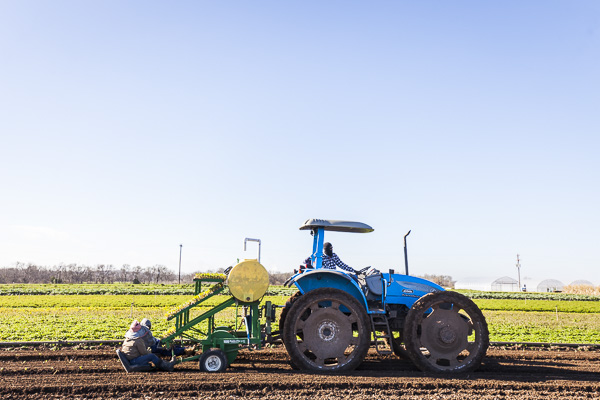 Photo by Scott David Gordon
Photo by Scott David Gordon
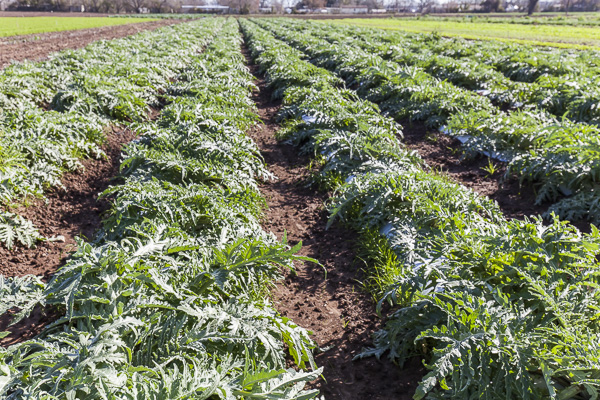 Artichokes enjoying the cooler weather. Photo by Scott David Gordon
Artichokes enjoying the cooler weather. Photo by Scott David Gordon
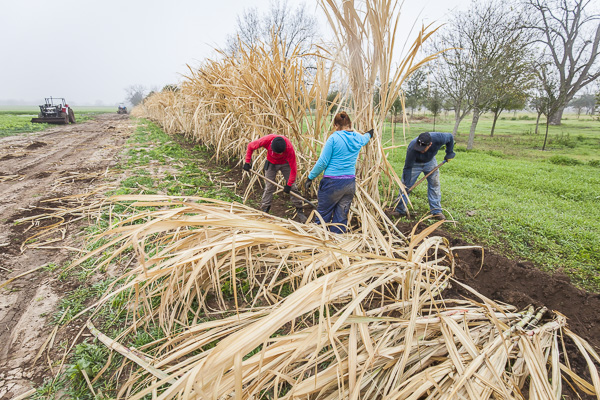 In January we built a "fence" of sorts, out of nothing other than sugar cane! Photo by Scott David Gordon
In January we built a "fence" of sorts, out of nothing other than sugar cane! Photo by Scott David Gordon
February:
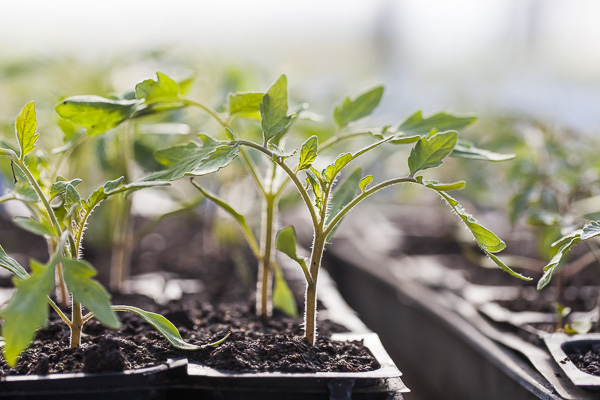 Tomatoes fill our greenhouse in February, to plant in March and sell at our annual Transplant Sale. Photo by Scott David Gordon
Tomatoes fill our greenhouse in February, to plant in March and sell at our annual Transplant Sale. Photo by Scott David Gordon
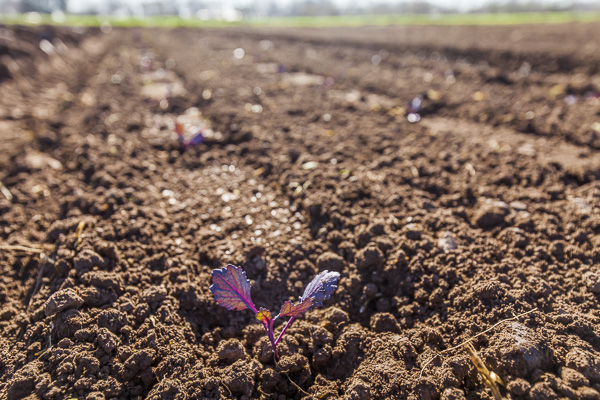 Red cabbage newly transplanted. Photo by Scott David Gordon
Red cabbage newly transplanted. Photo by Scott David Gordon
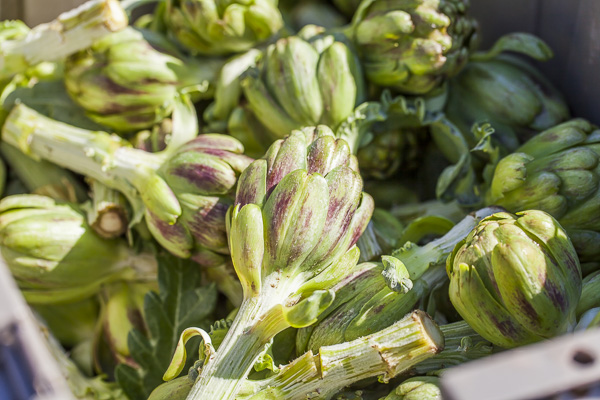 The first spring artichokes. Photo by Scott David Gordon
The first spring artichokes. Photo by Scott David Gordon
March:
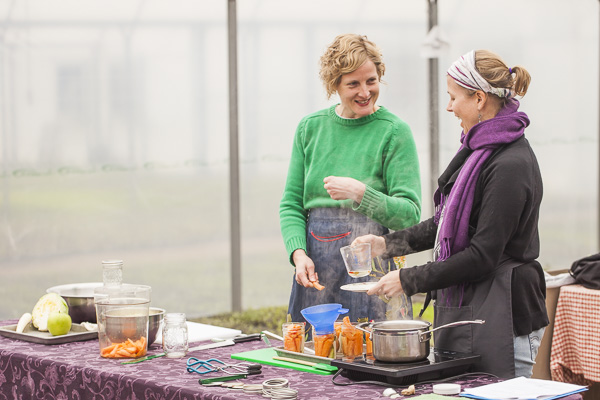 Kate Payne came for a great pickling class in March - the cold weather moved it into our greenhouses. Photo by Scott David Gordon
Kate Payne came for a great pickling class in March - the cold weather moved it into our greenhouses. Photo by Scott David Gordon
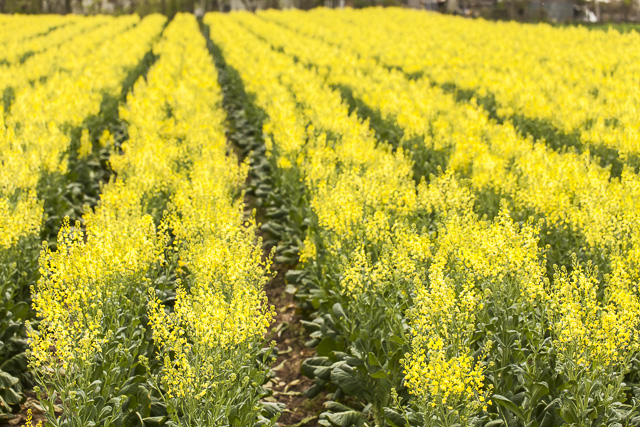 A field full of flowering collard greens. Photo by Scott David Gordon
A field full of flowering collard greens. Photo by Scott David Gordon
 Our first Spring strawberries! Photo by Scott David Gordon
Our first Spring strawberries! Photo by Scott David Gordon
April:
 The Spring Hoedown was a great way to kick off April. Photo by Scott David Gordon
The Spring Hoedown was a great way to kick off April. Photo by Scott David Gordon
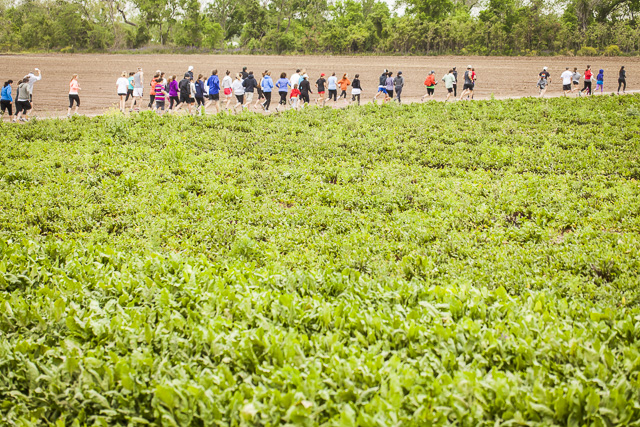 We hosted our first ever 5k on the farm this spring! Photo by Scott David Gordon
We hosted our first ever 5k on the farm this spring! Photo by Scott David Gordon
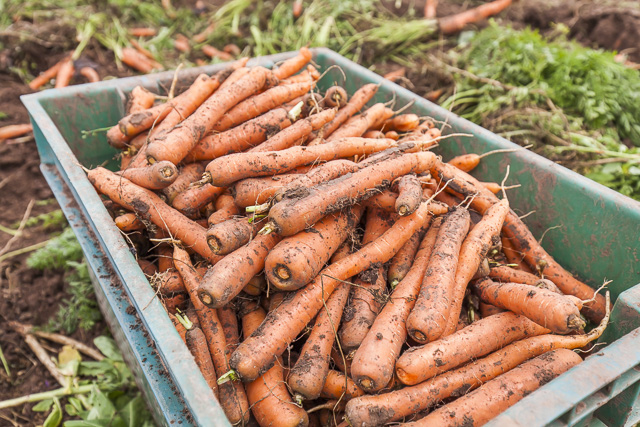 Overwintered carrots are the sweetest. Photo by Scott David Gordon
Overwintered carrots are the sweetest. Photo by Scott David Gordon
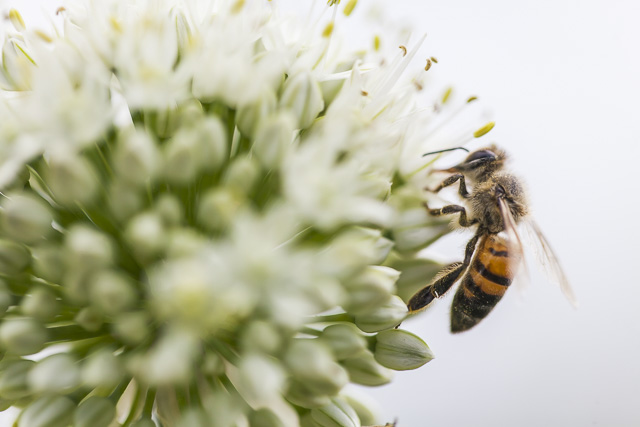 We had lots of flowering crops, like these onions, this Spring, which attracted loads of pollinators! Photo by Scott David Gordon
We had lots of flowering crops, like these onions, this Spring, which attracted loads of pollinators! Photo by Scott David Gordon
May:
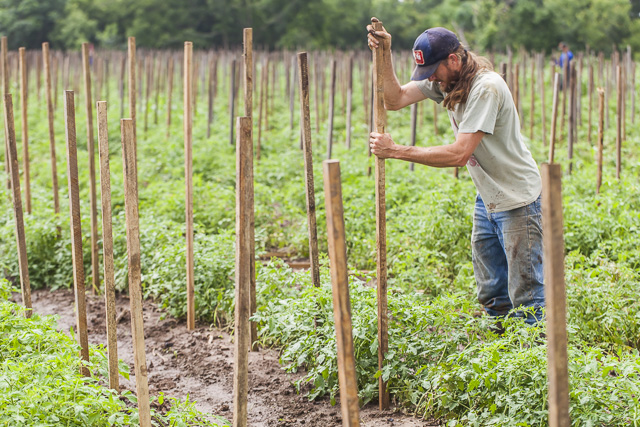 Montana pushes tomato stakes into the ground. Photo by Scott David Gordon
Montana pushes tomato stakes into the ground. Photo by Scott David Gordon
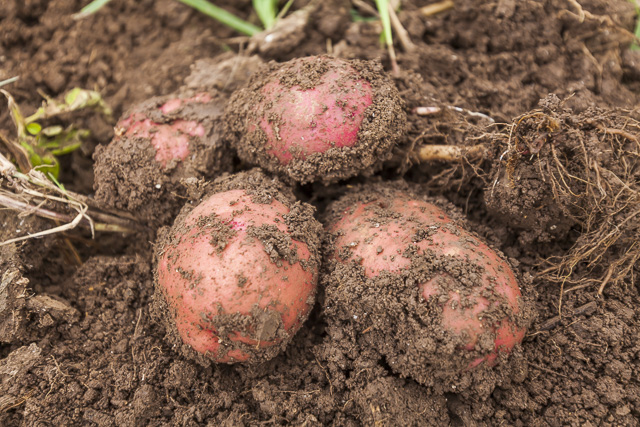 With a seriously rainy May, we had to dig all of your potatoes by hand this year! Photo by Scott David Gordon
With a seriously rainy May, we had to dig all of your potatoes by hand this year! Photo by Scott David Gordon
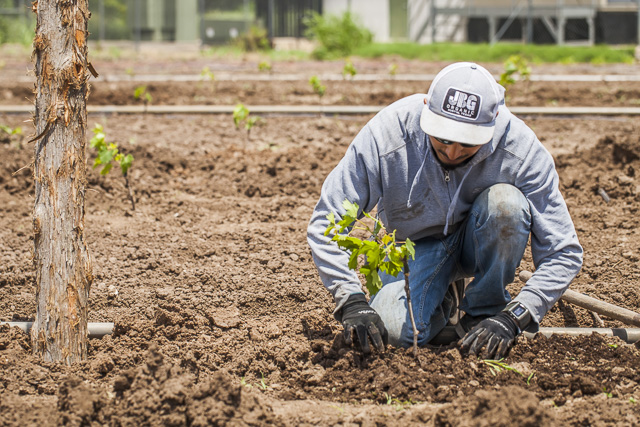 Temo puts a grape tranplant in the ground - we put in an acre of table grapes at JBG this year! Photo by Scott David Gordon
Temo puts a grape tranplant in the ground - we put in an acre of table grapes at JBG this year! Photo by Scott David Gordon
June:
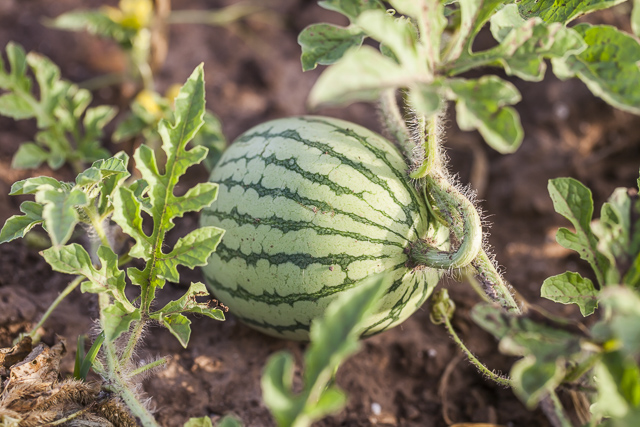 June means melons in Texas! Photo by Scott David Gordon
June means melons in Texas! Photo by Scott David Gordon
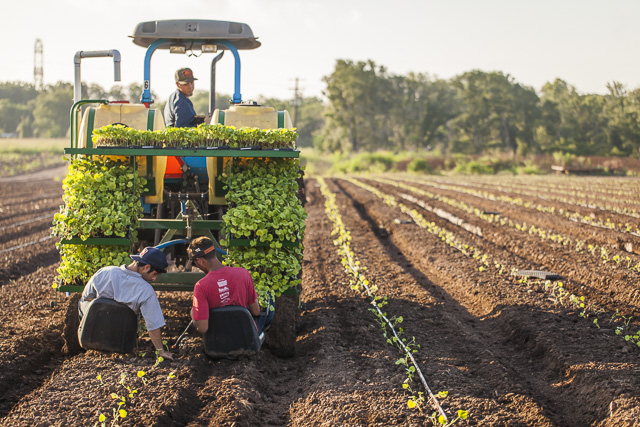 Transplanting hot-weather greens. Photo by Scott David Gordon
Transplanting hot-weather greens. Photo by Scott David Gordon
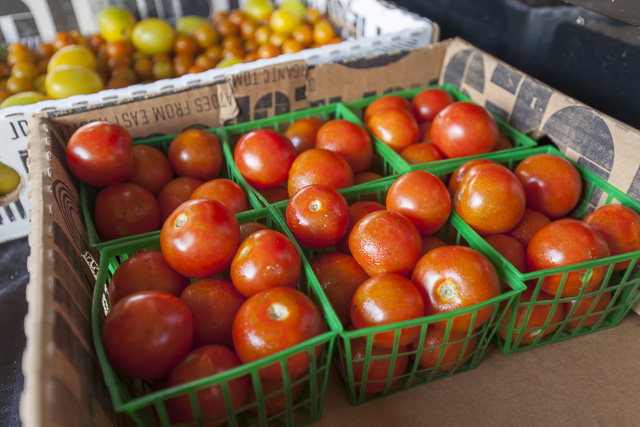 June also means...tomatoes! Photo by Scott David Gordon
June also means...tomatoes! Photo by Scott David Gordon
July:

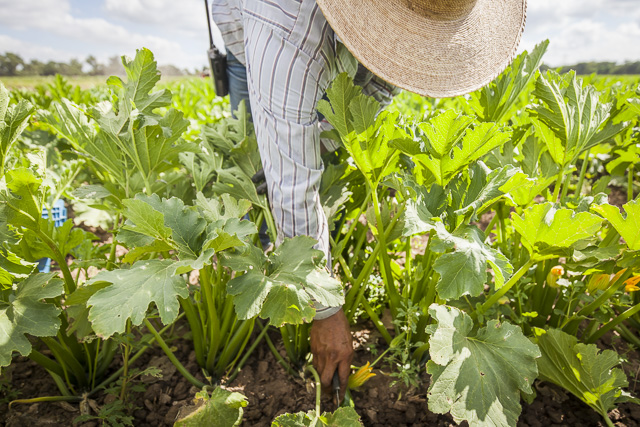 Harvesting zucchini. Photo by Scott David Gordon
Harvesting zucchini. Photo by Scott David Gordon
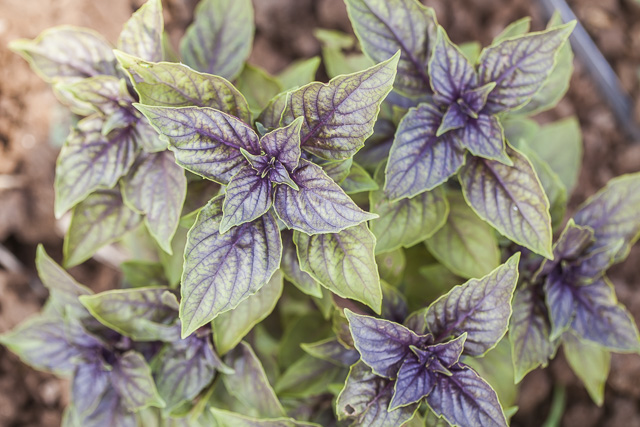 Purple basil growing in the field. Photo by Scott David Gordon
Purple basil growing in the field. Photo by Scott David Gordon
August:
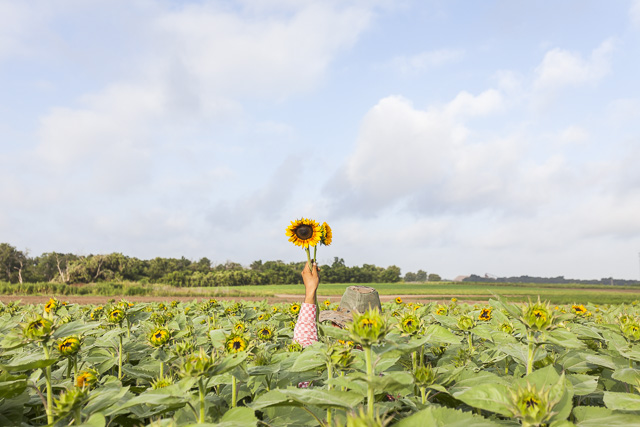 We grew a LOT of sunflowers this summer. Photo by Scott David Gordon
We grew a LOT of sunflowers this summer. Photo by Scott David Gordon
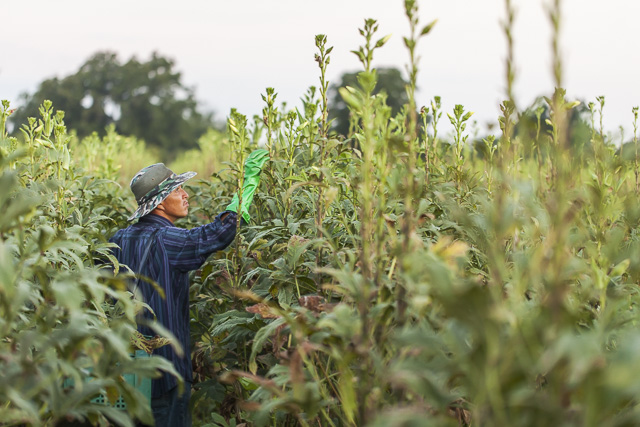 Early morning okra harvest. Photo by Scott David Gordon
Early morning okra harvest. Photo by Scott David Gordon
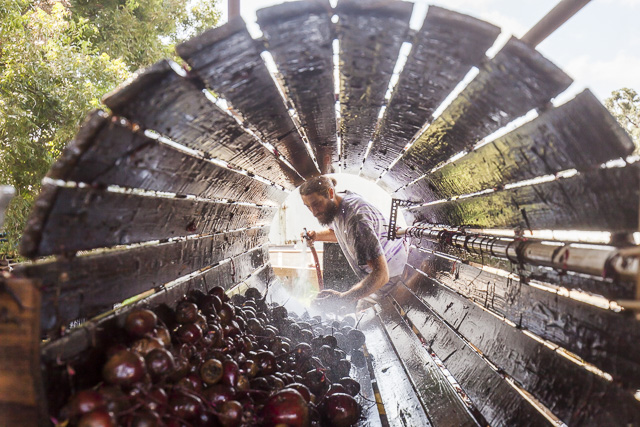 Andrew washes beets at our packing shed. Photo by Scott David Gordon
Andrew washes beets at our packing shed. Photo by Scott David Gordon
September:
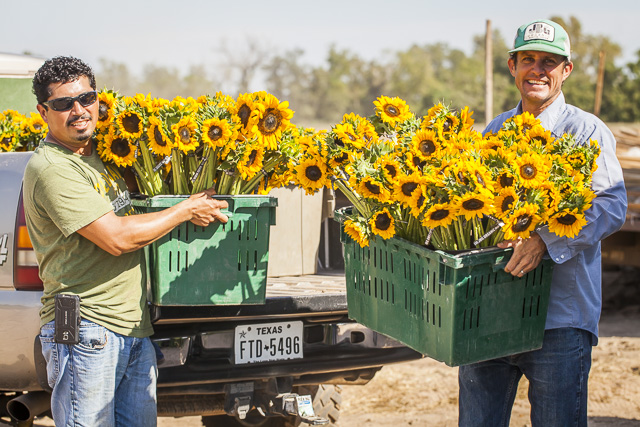 Brenton and Vicente bringing in a big flower harvest. Photo by Scott David Gordon
Brenton and Vicente bringing in a big flower harvest. Photo by Scott David Gordon
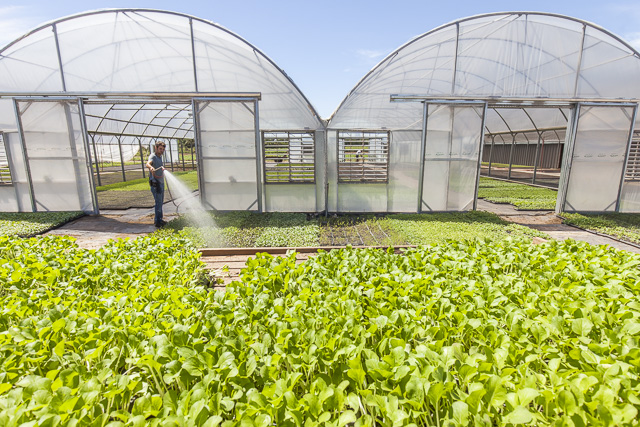 Our greenhouses are bursting at the seams with fall and winter transplants. Photo by Scott David Gordon
Our greenhouses are bursting at the seams with fall and winter transplants. Photo by Scott David Gordon
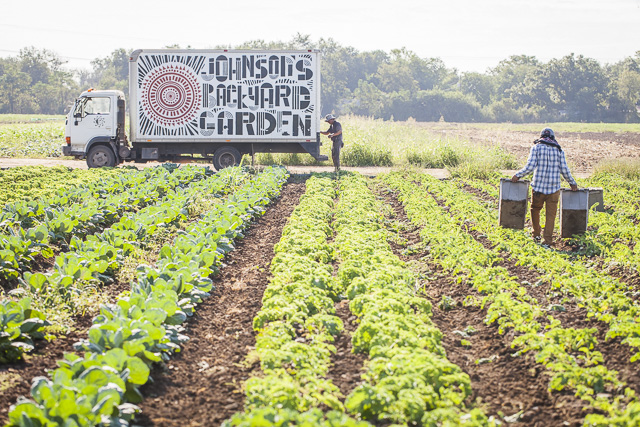 Late summer fields. Photo by Scott David Gordon
Late summer fields. Photo by Scott David Gordon
October:
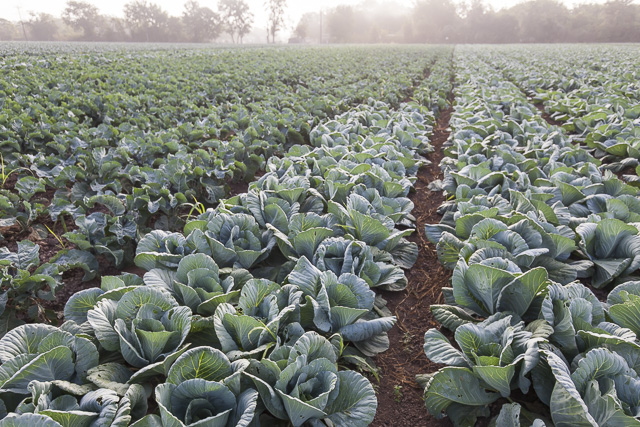 A misty morning in our cabbage patch. Photo by Scott David Gordon
A misty morning in our cabbage patch. Photo by Scott David Gordon
 Harvesting the first fall Collards. Photo by Scott David Gordon
Harvesting the first fall Collards. Photo by Scott David Gordon
 October brought new crops, but also the worst flood we've ever experienced at JBG. Photo by Scott David Gordon
October brought new crops, but also the worst flood we've ever experienced at JBG. Photo by Scott David Gordon
November:
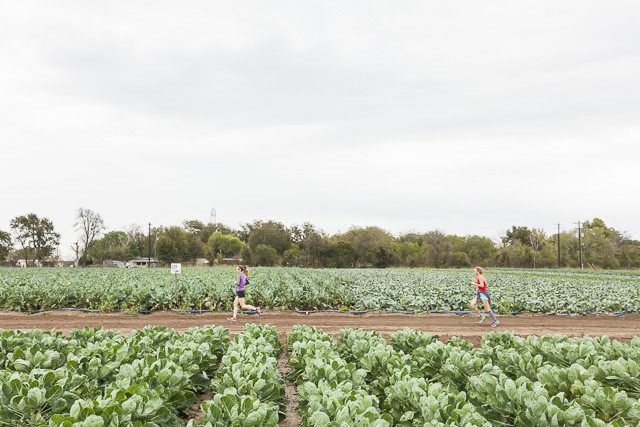 Runners in the fields during our second 5k, the Harvest Hustle, at the JBG Fall Picnic. Photo by Scott David Gordon
Runners in the fields during our second 5k, the Harvest Hustle, at the JBG Fall Picnic. Photo by Scott David Gordon
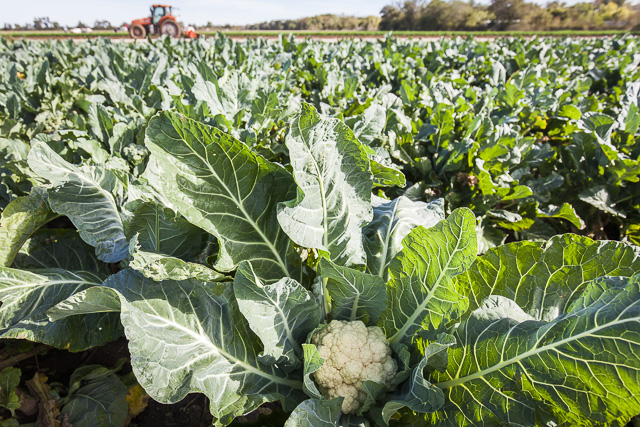 Cauliflower ready to harvest. Photo by Scott David Gordon
Cauliflower ready to harvest. Photo by Scott David Gordon
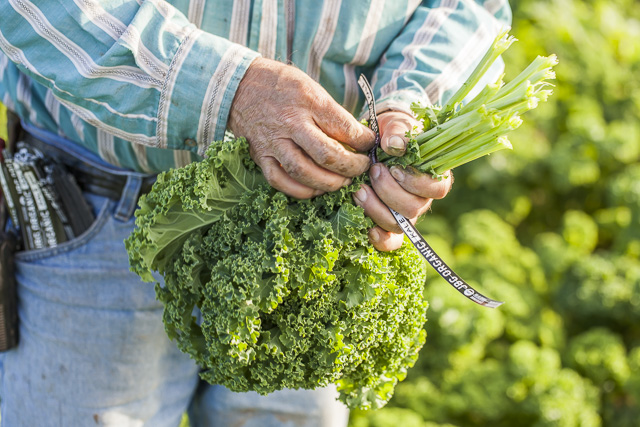 Photo by Scott David Gordon
Photo by Scott David Gordon
December:
 Young lettuce mix. Photo by Scott David Gordon
Young lettuce mix. Photo by Scott David Gordon
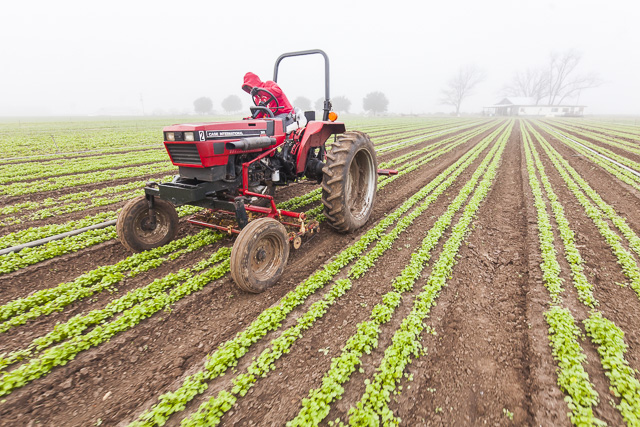 Cultivating on a foggy morning. Photo by Scott David Gordon
Cultivating on a foggy morning. Photo by Scott David Gordon
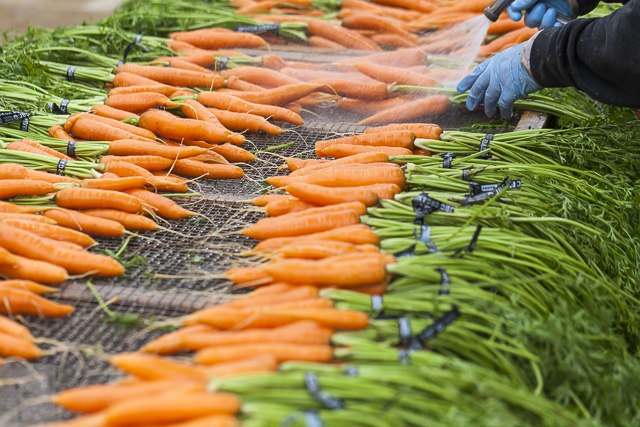 Washing those famous JBG Homegrown Carrots at our packing shed. Photo by Scott David Gordon
Washing those famous JBG Homegrown Carrots at our packing shed. Photo by Scott David GordonCSA BOX CONTENTS WEEK OF JAN 4TH
01/05/16 — Scott
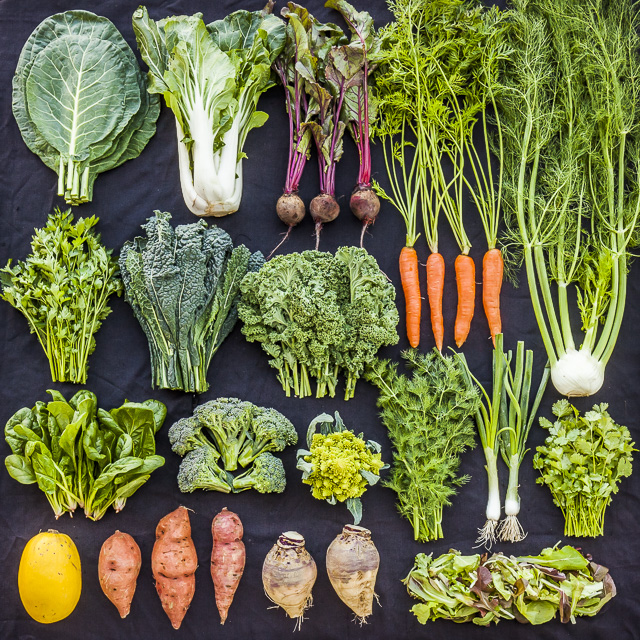 CSA Box Contents Week of Jan 4th
CSA Box Contents Week of Jan 4th
Beet, Golden
Broccoli
Cabbage, Red
Carrot, Orange
Greens, Broccoli Rabe
Greens, Chard, Rainbow
Greens, Kale, Dino
Greens, Salad Mix
Herb, Dill
Herb, Fennel
Onion, Spring Yellow
Potato, Sweet
Turnip, Rutabaga
Beet, Red
Broccoli
Carrot, Orange
Greens, Broccoli Rabe
Greens, Kale, Dino
Greens, Salad Mix
Greens, Spinach
Herb, Dill
Herb, Fennel
Potato, Sweet
Cabbage, Red
Carrot, Orange
Greens, Kale, Curly
Greens, Spinach
Herb, Cilantro
Potato, Sweet
Radish, Watermelon
Broccoli
Greens, Chard, Rainbow
Greens, Spinach
Kohlrabi, Purple
Onion, Spring Yellow
Potato, Sweet
CSA BOX CONTENTS WEEK OF JAN 4TH
01/05/16 — Scott
 CSA Box Contents Week of Jan 4th
CSA Box Contents Week of Jan 4th
Medium Box
Beet, Red
Bok Choy
Carrot, Orange
Cauliflower, Romanesco
Greens, Collards
Greens, Kale, Dino
Greens, Salad Mix
Herb, Dill
Herb, Fennel
Potato, Sweet
CHARRED ROMAINE WITH CRISPY ONIONS
01/05/16 — Farm
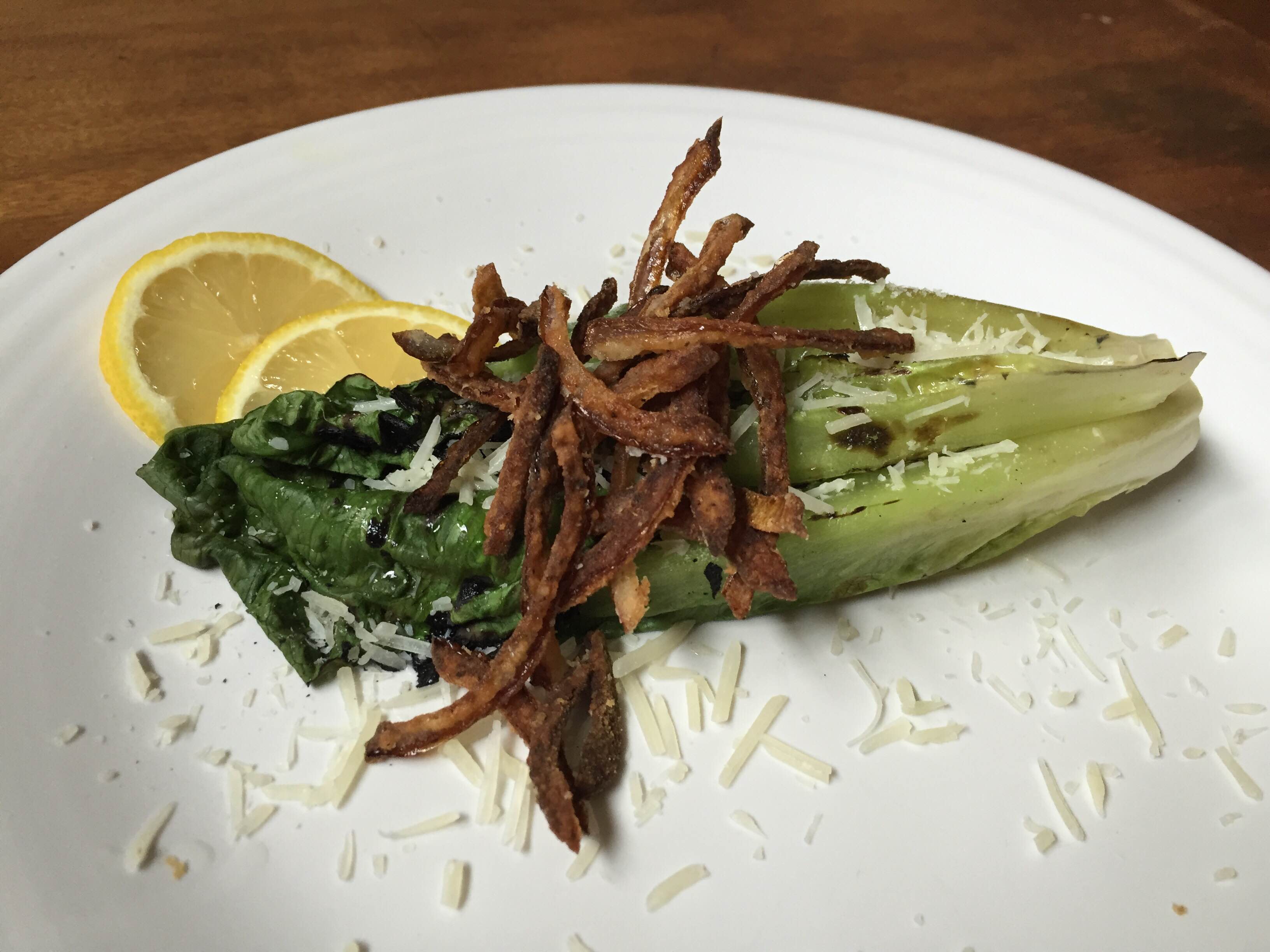
by Megan Winfrey
Simple and sophisticated describe this week's recipe to a T. Instead of making the same, albeit delicious salad you've been making with all of that gorgeous romaine, try this recipe and I guarantee you'll feel like you're at a nice restaurant. The flavors are complex yet bright, and it's so easy to make that I did it in about 5 minutes with a 9 month old on my hip. It doesn't get much better that that, now does it? Enjoy!
Charred Romaine with Crispy Onions
- 1 head of romaine lettuce, outer leaves trimmed
- 1/4 cup sliced onion
- 1/4 cup all purpose flour
- 4 tbs. olive oil
- half a lemon
- salt and pepper
- parmesan cheese
Using your gas burner or grill, spray a bit of cooking oil onto the grate and start a low flame. Place the bunch of romaine right over the flame and cook until char marks form, about 3 minutes on each side.
Immediately plate the romaine and sprinkle with parmesan cheese. Pile the crispy onions on top and finish with a generous sprinkle of lemon juice.
WEEK 1 IN PHOTOS
01/08/16 — Farm
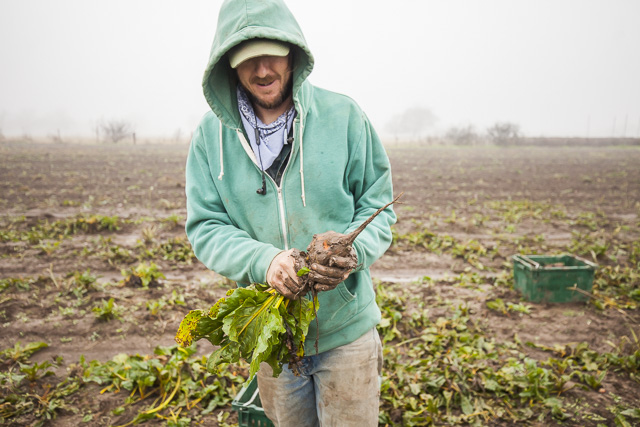 Montana harvests a big golden beet. Photo by Scott David Gordon
Montana harvests a big golden beet. Photo by Scott David Gordon
It sure was muddy when Scott came out to the farm this week! We've got lots of delicious winter root vegetables coming out of the ground, along with greens and herbs to round out the market tables. This week we started seeding in our greenhouse for the annual JBG Transplant Sale, which will start on March 5th and run for 2 weekends and a special third pop-up market - get your gardens ready and stay tuned!
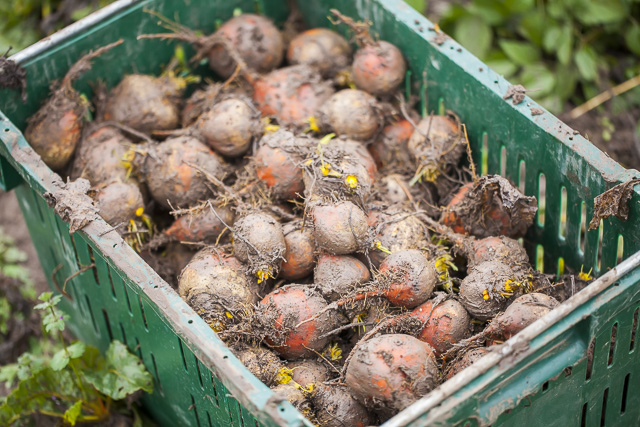 Photo by Scott David Gordon
Photo by Scott David Gordon
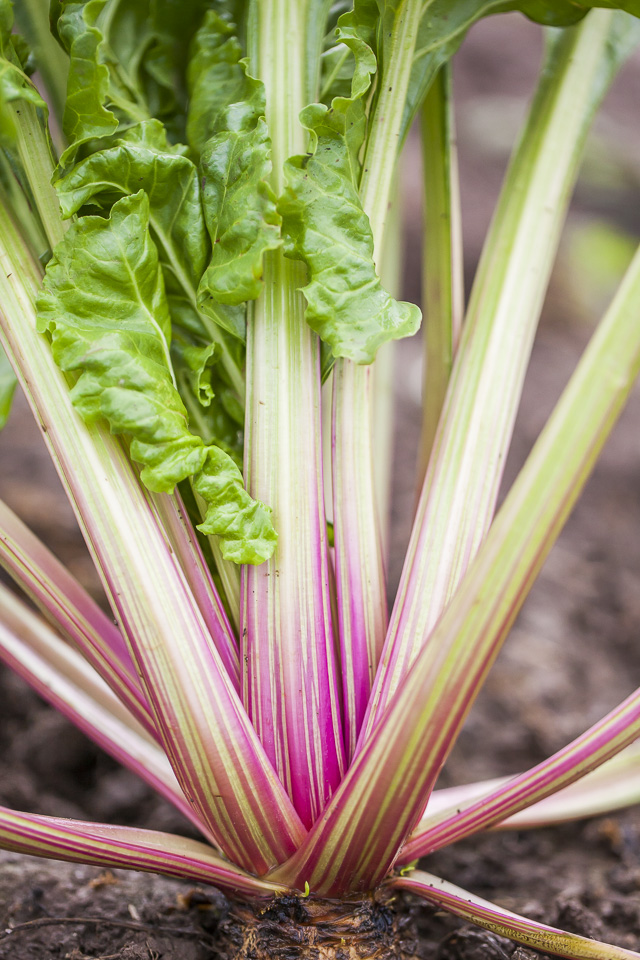 Chioggia beets have the best stems. Photo by Scott David Gordon
Chioggia beets have the best stems. Photo by Scott David Gordon
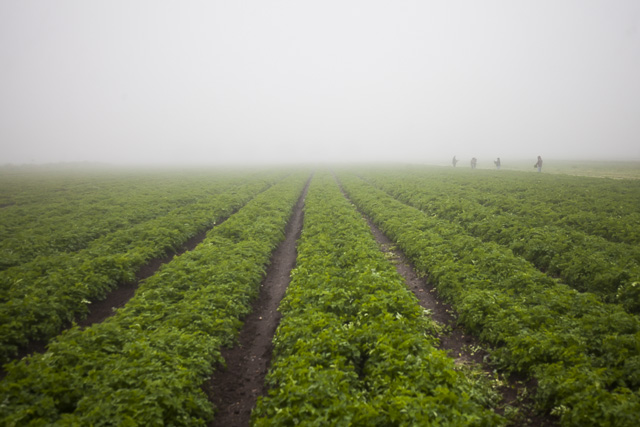 A foggy morning harvesting parsley. Photo by Scott David Gordon
A foggy morning harvesting parsley. Photo by Scott David Gordon
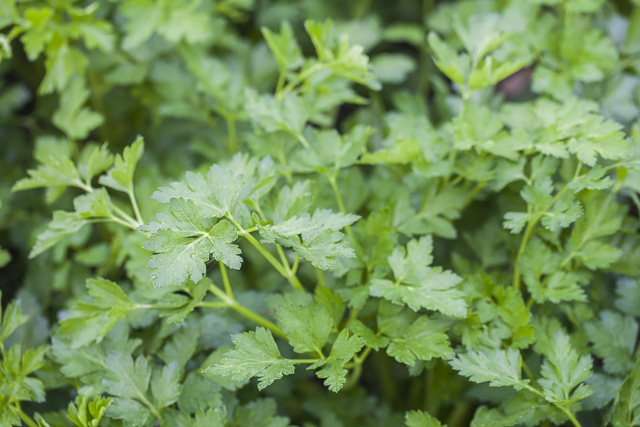 Parsley. Photo by Scott David Gordon
Parsley. Photo by Scott David Gordon
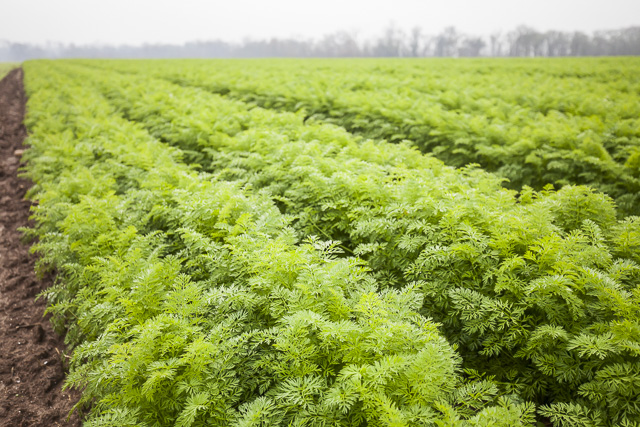 Those carrots are sure loving this weather. Photo by Scott David Gordon
Those carrots are sure loving this weather. Photo by Scott David Gordon
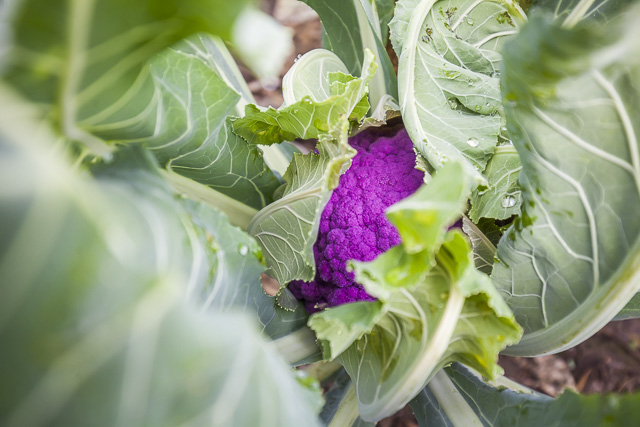 A purple cauliflower peeks out from its inner leaves. Photo by Scott David Gordon
A purple cauliflower peeks out from its inner leaves. Photo by Scott David Gordon
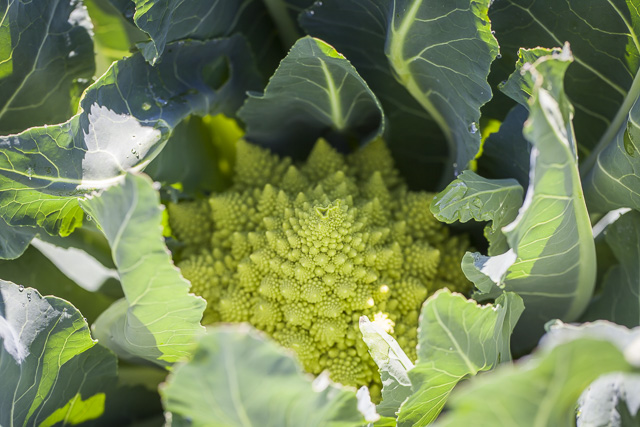 Romanesco. Photo by Scott David Gordon
Romanesco. Photo by Scott David Gordon
 A carrot harvest. Photo by Scott David Gordon
A carrot harvest. Photo by Scott David Gordon
 Lots of mud on the farm this week. Photo by Scott David Gordon
Lots of mud on the farm this week. Photo by Scott David Gordon
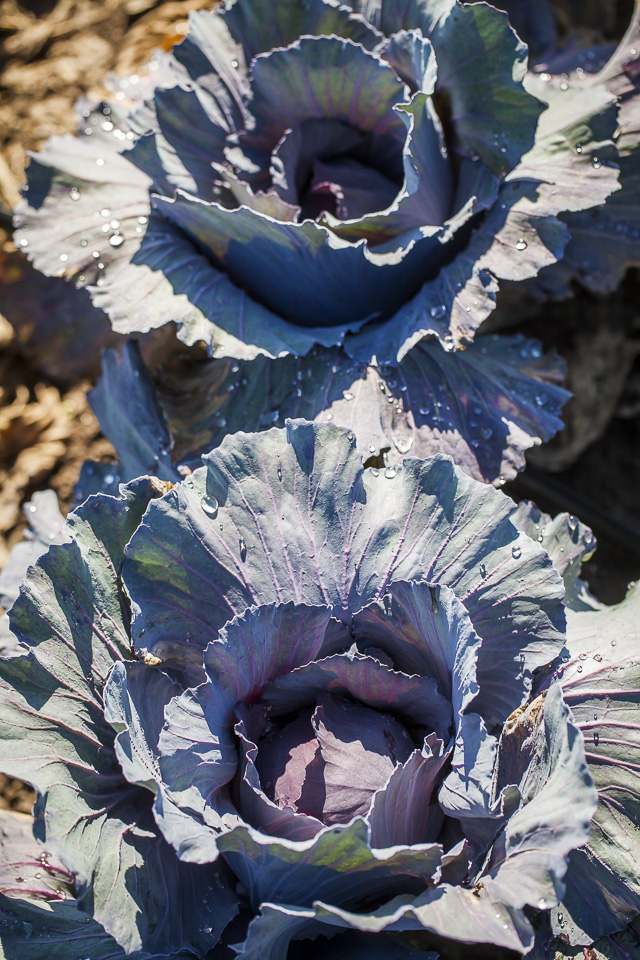 Purple cabbage in the fields. Photo by Scott David Gordon
Purple cabbage in the fields. Photo by Scott David Gordon
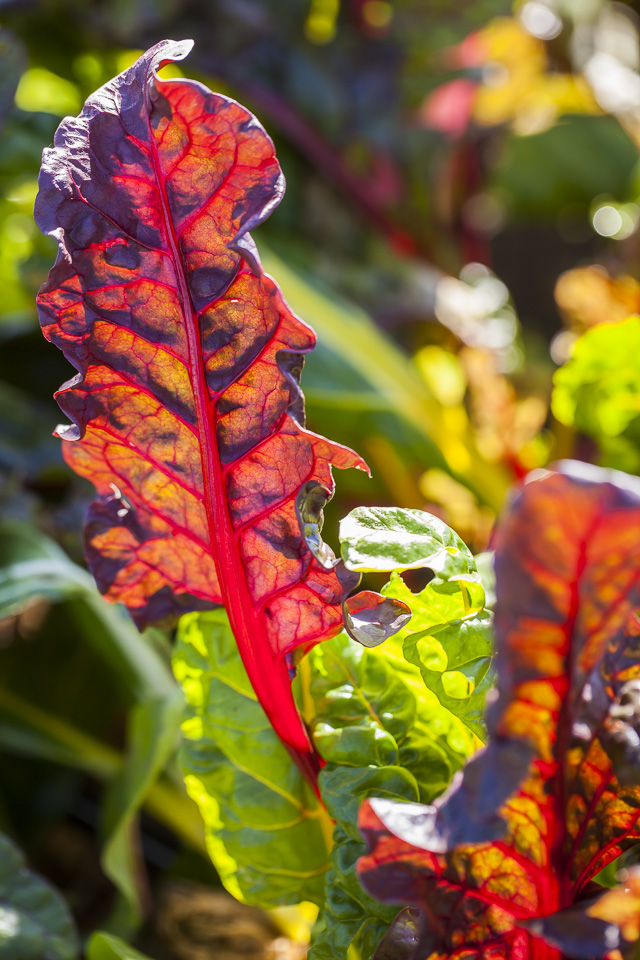 Vibrant rainbow chard. Photo by Scott David Gordon
Vibrant rainbow chard. Photo by Scott David Gordon
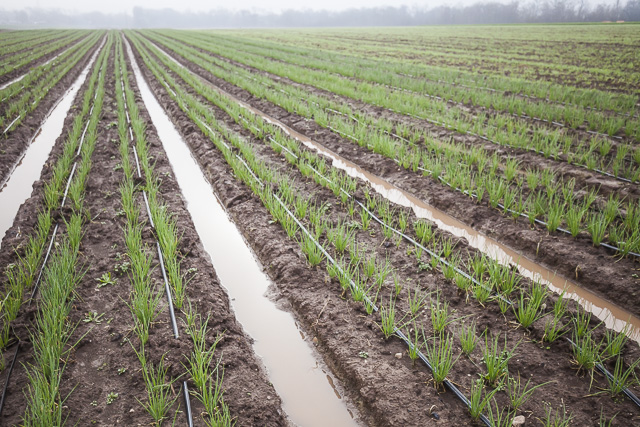 Our newly planted onions are definitely getting watered. Photo by Scott David Gordon
Our newly planted onions are definitely getting watered. Photo by Scott David GordonTHANK YOU! WE REACHED OUR SPONSORED SHARE GOAL!
01/08/16 — Farm
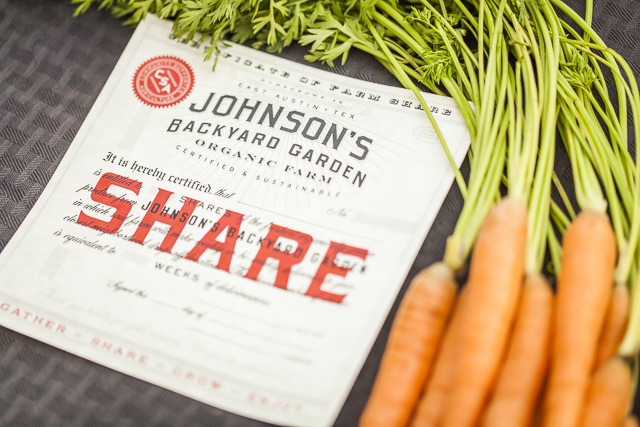
This holiday season, we challenged our CSA community to help us meet our goal of 150 CSA shares donated to The Settlement Home through our Sponsored Share Program. We are thrilled to announce that we nearly DOUBLED this donation with 290 shares!! Your outpouring of support will feed hundreds of meals to community members who have suffered abuse, neglect and trauma through the work of the Settlement Home. Thank you!
Our Sponsored Share Program runs year round, so if you missed your chance to donate for the holidays, fear not! You can visit the Sponsored Share page to learn more and join.
26 REASONS TO JOIN THE CSA IN 2016
01/08/16 — Farm
26 Reasons to Join the CSA in 2016
This week we've got 26 reasons that 2016 should be the Year of the CSA for you and your family! Those new years resolutions to eat healthy? Easier than ever with JBG. Signing up for our CSA is quick and easy - join the farm today and start your vegetable deliveries next week!
-
FREE CITRUS!
We're starting here because this offer is ending soon! New members to our CSA get a free bag of citrus just for joining the farm - use the code NWYR at checkout. Existing members - you can get free citrus too, by committing to a long-term share this year! Read more here and email the farm to start your commitment. -
BUY LOCAL
By joining a CSA, you are supporting a locally owned and operated business and keeping your dollars in the Texas economy. Unique local businesses are part of what makes Austin and Texas so special! -
FOR YOUR HEALTH
Plant-based and plant-rich diets are a great way to jump-start your road to health this year, and organically grown is as good as it gets. Joining our CSA is a commitment to home-cooked, health filled meals. Plus, sharing these eating habits with your kids will ensure they live long and healthy lives.![_MG_6848]()
-
TRY NEW FOODS
Kohlrabi and fennel? Komatsuna? Expand your culinary horizons each week when you open your box of goodies and dream up some awesome dishes. We also help you out by posting weekly seasonal recipes to our blog. (Psst.. decide you don’t like something? Customize your share and we won’t send it to you again!) -
FOR THE ENVIRONMENT
Supporting your local farm ensures sustainable land management, and organic certification ensures that we never spray harmful chemicals on the farm. East Austin housing developments? Never on this land!
![Photo by Scott David Gordon]() Photo by Scott David Gordon
Photo by Scott David Gordon -
MAYBE YOU DON'T HAVE A GREEN THUMB
That's okay, we've got a few out here! Our team is dedicated to growing the best organic vegetables in town and we've got years of experience. -
CUT DOWN YOUR FOOD MILES
It's estimated that the average American meal travels over 1500 miles before making it to a dinner plate. With all of that fuel, even a plant-based meal might not be too eco-friendly. In contrast, our farm is located just 10 miles east of the Austin airport! -
ONLY THE FRESHEST
Less food miles also means that your produce is much fresher when it gets to you. Most of your CSA produce was harvested no more than a day or two before it makes it to your doorstep, which means its has peak nutrition and flavor.![151202_SDG259150]()
-
DISCOVER THE SEASONS
Eating locally connects you to the seasons, to the land, and to your own health and wellness. Cucumbers will cool you down in the summer, while braised collards will warm you up when the temperatures start to drop. Enjoy the best pico de gallo of your life during the short window when cilantro, onions, peppers, and tomatoes all overlap and we promise you'll never go back to the store-bought stuff again. -
IF IT'S GOOD ENOUGH FOR PAUL...
And yes, we mean Qui. Great chefs all over Austin use JBG's produce because it's the best around! Why shouldn't your family too?![thumbNew]()
-
SHAKEY GRAVES KEEPS GIVING OUR HATS AWAY AND WE CANT AFFORD TO SEND HIM MORE WITHOUT YOUR HELP
These hats, while awesome, are not edible. If you rep JBG on your head but not on your plate, maybe 2016 is the year to make the shift? -
KNOW YOUR FARMERS
Brenton manages the fields, Krishna crunches the numbers, Matt and crew pack and inspect all of your CSAs each week (while blaring old-time country tunes), and Ada manages outreach, events, and makes sure we're all having fun. Come out to an event or volunteer at the farm and get to know us! We're regular old Austinites just like you. -
KNOW YOUR FOOD
With all of the recalls, health scares, scary articles and stories around the food industry these days, getting a CSA share with JBG ensures you know exactly where your food is coming from and how it's grown. GMO? Heck no! Come out for a volunteer day and see your crops in the field and ask your farmers about it! -
AWESOME DELIVERY DRIVERS
The modern-day milkmen.![Screen Shot 2016-01-07 at 5.53.52 PM]()
-
IT'S LIKE CHRISTMAS EVERY WEEK
Our delivery drivers are a group of jolly men (like Santa!) who deliver boxes of surprises to your doorstep each week. Like this summer, when they left sunflowers on porches all over Austin along with the usual CSA deliveries - what more could you ask for? -
DIVE INTO OUR FARM COMMUNITY
The "C" in CSA is important to us all at JBG. That's why we host twice-annual Potlucks, fun runs on the farm, cooking classes, pop-ups, plant sales, and more to encourage members to get out and meet their farmers and their neighbors. Your community pick-up location is a great place to trade recipes, ideas and more!![151114_SDG256081]()
-
SAVE VALUABLE TIME EACH WEEK
We bring the farm to you - either to a community site or right to your doorstep! We know you're busy, so save those hours spent at the grocery store by getting your veggies delivered in a CSA box each week. Give yourself permission to be a little lazy! -
LEARN HOW TO PICKLE AND PRESERVE
We aim to provide a big bounty of food for your family each week. We hope that we give you enough of your favorite veggies so that you can put up pickles, kraut, and kimchi for the off-season. We post recipes and host classes on preservation too! -
EVEN OUR CARROTS LOVE OUR CARROTS
Not only are they delicious, but when was the last time you saw something this cool in the supermarket?![Screen Shot 2016-01-07 at 5.38.52 PM]()
-
NO MIDDLEMEN
When you buy direct from our farm, more money goes direct to your farmers, which means that we can pay higher wages to our employees, and dedicate more efforts towards sustainability on the farm. When you buy from a supermarket, your farmers don't receive that same margin. -
HELP FEED THOSE IN NEED
Thanks to the support of our CSA members, JBG is able to donate thousands of pounds of produce every year to large operations like the Capital Area Food Bank, as well as grassroots efforts like Nubian Queen Lola who are both helping to ensure that the hungry in Austin are fed.![151207_SDG259449]()
-
FLEXIBLE SCHEDULING
We understand that you like to take vacations. And that some weeks you just don't have the time to cook. Maybe your garden is just having a bumper crop this week. That's why we make it easy to postpone your CSA deliveries any week of the year either online or by calling the farm. -
FARM FRESH WATERMELON WHEN IT'S 110 DEGREES OUTSIDE
![Screen Shot 2016-01-07 at 5.36.42 PM]()
-
FOR THE LOVE OF ART
C'mon, what would you do without Lucas and his farm-toons, or Amy and her amazing veggie art? Buying a CSA share supports our employees and all the wonderful things they do for the farm. -
OPTIONS OPTIONS OPTIONS
We've got 4 sizes to suit your needs - individuals to large families can all choose the size to suit them. JBG offers add-ons of local eggs from pasture-raised hens, and small batch locally roasted coffee as well. Finally, you can CUSTOMIZE your share each week, ensuring that you get the veggies to suit your household best! -
HOT PINK CHARD AND ROMANESCO CAULIFLOWER AND PURPLE PEPPERS EXIST, AND WE THINK YOU SHOULD KNOW ABOUT THEM (AND EAT THEM TOO!)
![Screen Shot 2016-01-07 at 6.28.40 PM]()
![Screen Shot 2016-01-07 at 6.27.09 PM]()
![Screen Shot 2016-01-07 at 6.31.36 PM]()
Join the CSA at Johnson's Backyard Garden today - it's never been easier, and it's a great way to start the New Year off right. Sign-up here - don't forget to claim your citrus as a treat from us when joining!
CSA BOX CONTENTS WEEK OF JAN 11TH
01/12/16 — Scott
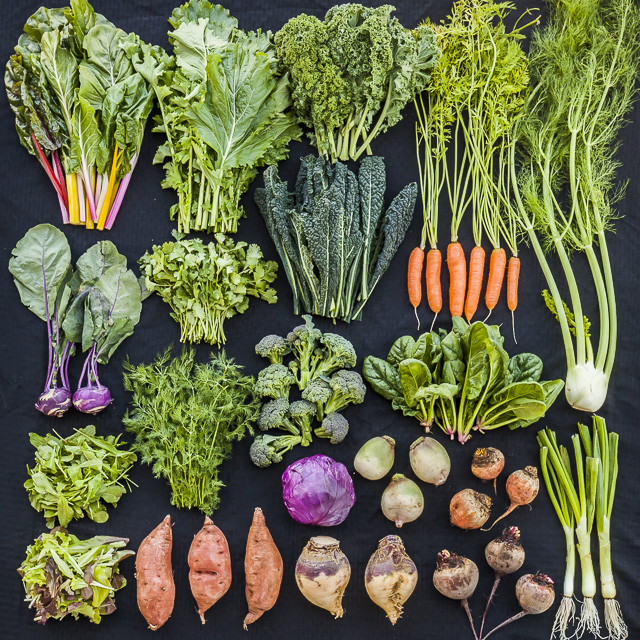 CSA Box Contents Week of Jan 11th
CSA Box Contents Week of Jan 11th
Beet, Golden
Broccoli
Brussels Sprouts
Cabbage, Red
Carrot, Rainbow
Greens, Collards
Greens, Kale, Curly
Greens, Mizuna
Greens, Salad Mix
Greens, Spinach
Herb, Parsley, Flat
Potato, Sweet
Turnip, White Japanese
Broccoli
Cabbage, Red
Carrot, Orange
Greens, Collards
Greens, Kale, Curly
Greens, Salad Mix
Greens, Spinach
Herb, Parsley, Flat
Scallions
Turnip, White Japanese
Beet, Red
Carrot, Orange
Greens, Chard, Rainbow
Greens, Collards
Herb, Fennel
Lettuce, Red Leaf
Scallions
Turnip, Rutabaga
Beet, Red
Bok Choy
Carrot, Orange
Greens, Kale, Curly
Herb, Cilantro
Lettuce, Red Leaf
CSA BOX CONTENTS WEEK OF JAN 11TH
01/12/16 — Scott
 CSA Box Contents Week of Jan 11th
CSA Box Contents Week of Jan 11th
Medium Box
Beet, Red
Broccoli
Carrot, Orange
Greens, Broccoli Rabe
Greens, Kale, Dino
Greens, Salad Mix
Greens, Spinach
Herb, Dill
Herb, Fennel
Potato, Sweet
FENNEL SAUERKRAUT
01/12/16 — Farm
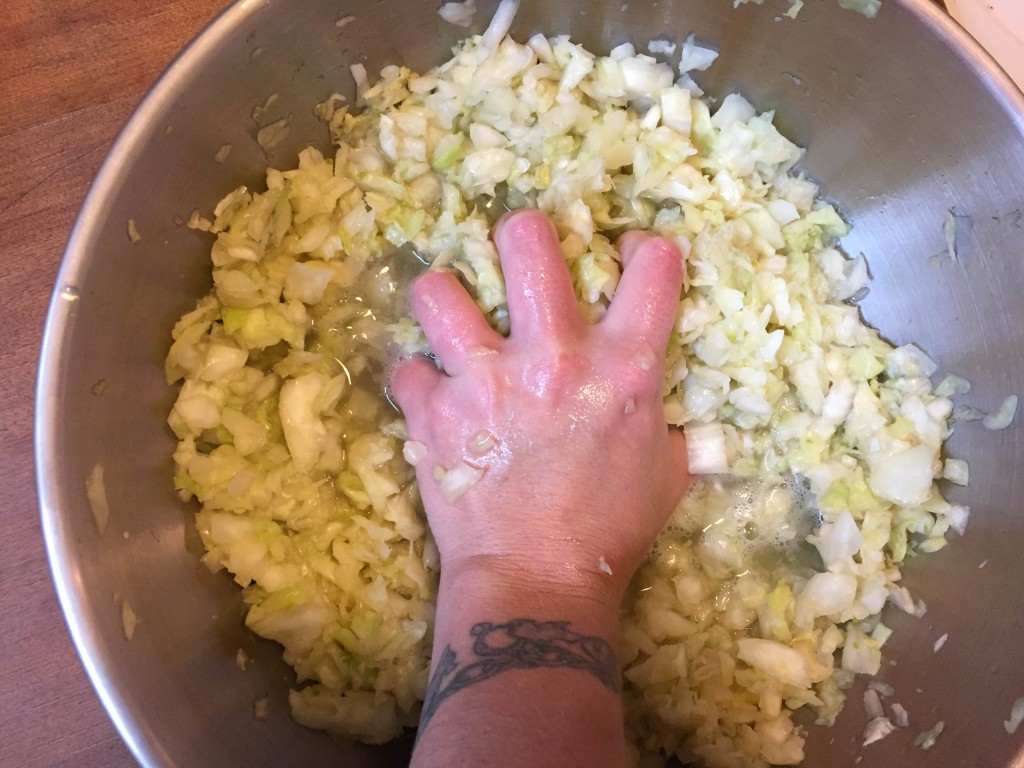
by Megan Winfrey
I've read that in cultures where fermented foods are eaten regularly, people are known to live longer lives. (link to credible article)
The lactic acid that is formed during the fermentation of cabbage is a known probiotic and wonderful for your digestive system, and has also been shown to prevent cancer. Now I know what you're thinking. Sauerkraut, gross. But let me ask you this. When was the last time you tried it?
If the answer is more than 10 years ago, you need to give it another shot. I am a firm believer in re-trying your most hated foods every decade or so. In my experience, when someone says they don't like something, it's because they haven't had it in forever or it wasn't prepared correctly. If you give this recipe a shot, not only will you love it, but you will feel extremely accomplished for having made it (even though it's really simple!)
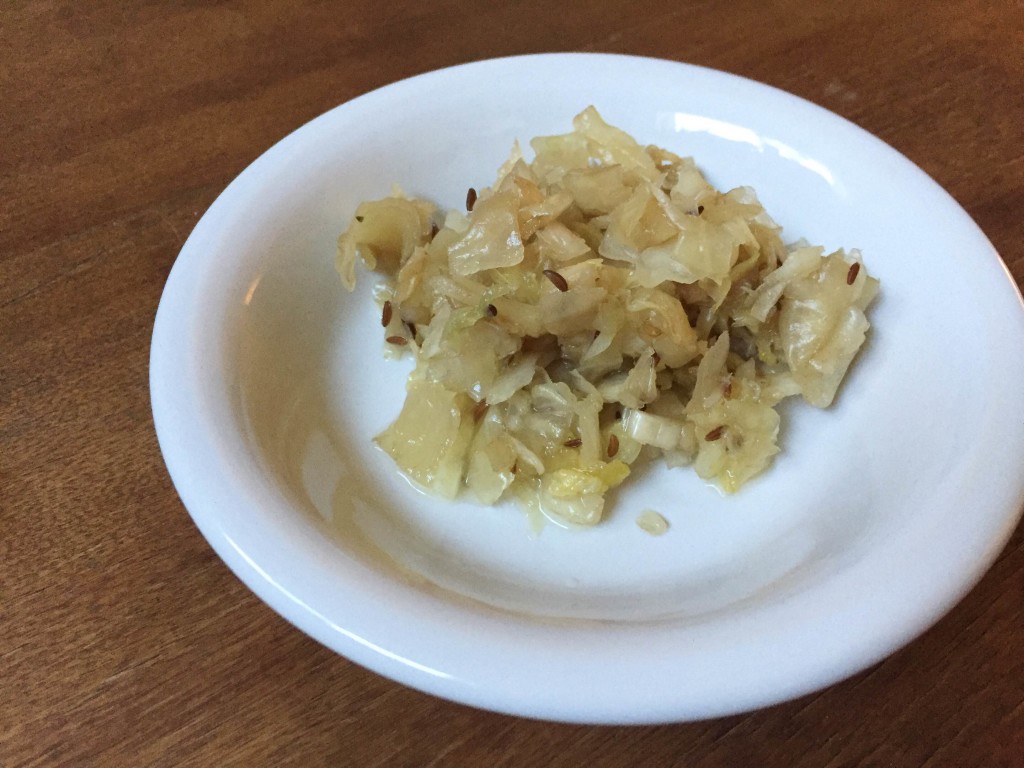
Sauerkraut with Fennel
- 2 heads of cabbage, shredded
- 2 fennel bulbs, thinly sliced
- 3 tbs. caraway seeds
- 3 tbs. kosher or pickling salt
- 1 large glass pitcher or mason jar
- 1 large mixing bowl
- 1 rubberband
- 1 clean dish towel
- 1 clean, small glass
- 4-5 clean rocks or marbles
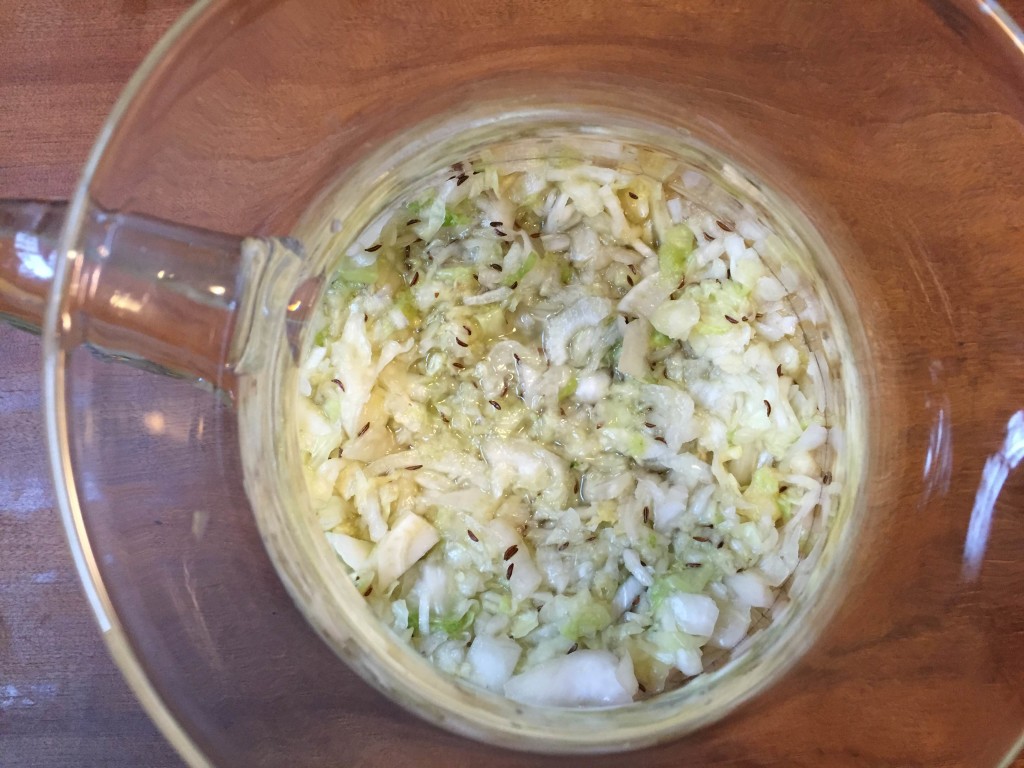
Once everything is clean, put all of the shredded cabbage into a large bowl. Add the salt and begin massaging the cabbage with your hands. Do this for about 10 minutes, or until the cabbage is wilted and resembles coleslaw, and there is about a cup of juice in the bottom of the bowl. Mix in the fennel and caraway seeds. and transfer everything into the glass pitcher, packing the mixture down with your fist as you go. There should be enough liquid to cover or almost cover all of the cabbage in the pitcher. If not, add enough water just to cover.
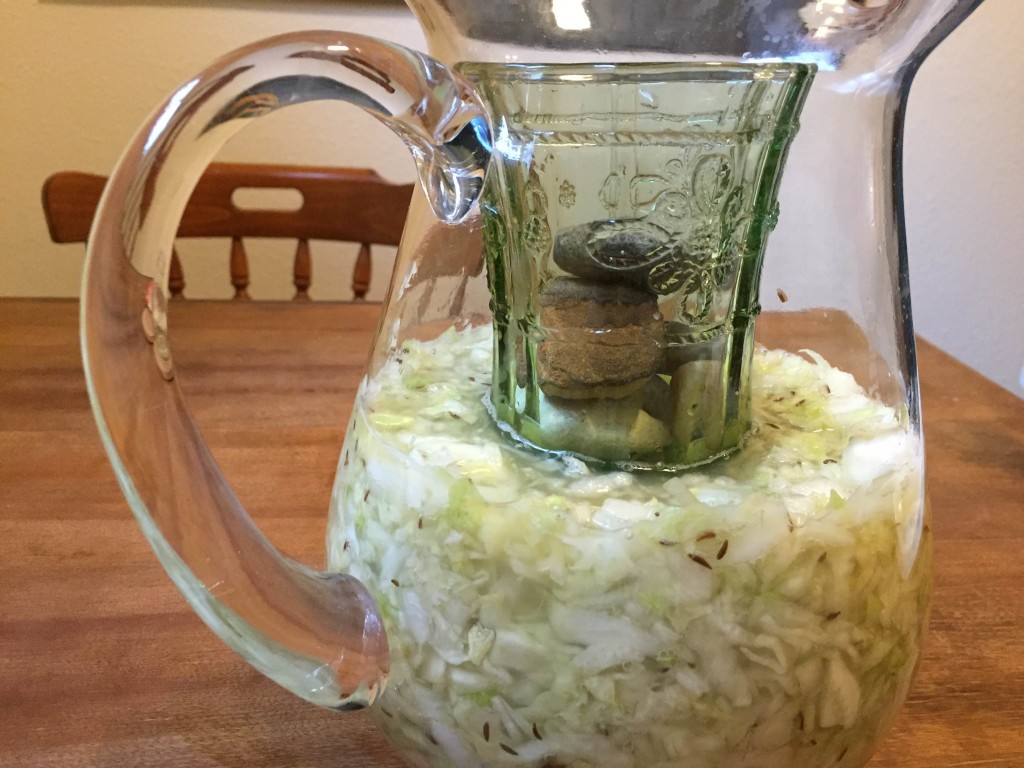
The cabbage will have to be weighed down so that it stays submerged in the liquid. Put the clean rocks or marbles into the small glass (made of glass) and lower that down into the pitcher on top of the cabbage and press down. Cover the mouth of the pitcher with the clean dish towel, and secure with a rubber band. This will keep oxygen out of the fermentation process. Store the pitcher in a cool, dark place like a closet or pantry for at least 5 days, or up to 10 depending on how "sour" you like it. Start tasting on day 5, and either begin using it or let it ferment until it is to your liking.
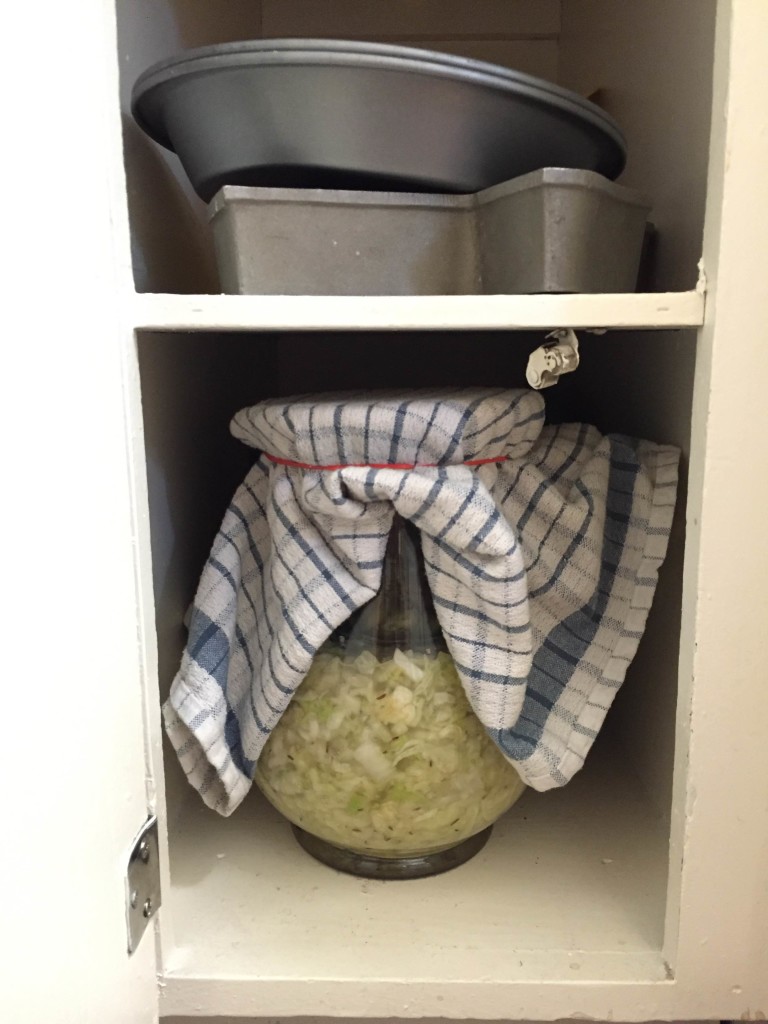 The sauerkraut will keep in the refrigerator for 2 months, or longer if you separate it out into smaller containers. As long as it looks and smells good, it's okay to eat. You can also can it in jars for an indefinite shelf life.
The sauerkraut will keep in the refrigerator for 2 months, or longer if you separate it out into smaller containers. As long as it looks and smells good, it's okay to eat. You can also can it in jars for an indefinite shelf life.
My favorite way to eat sauerkraut is on top of a grilled bratwurst with lots of German mustard and a crusty bun, but there are lots and lots of ways to enjoy it. Here's a link to a few great recipes!
WEEK 2 IN PHOTOS
01/15/16 — Farm
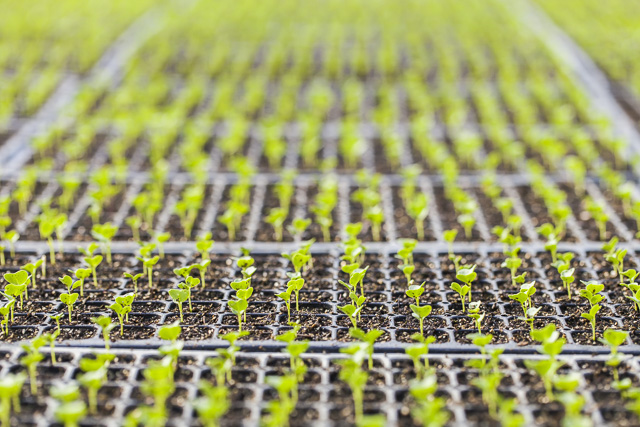 See you on February 27th for the annual Transplant Sale! Photo by Scott David Gordon
See you on February 27th for the annual Transplant Sale! Photo by Scott David Gordon
Another beautiful week on the farm gone by! We're keeping busy seeding plenty of crops for Spring, as well as for our annual Transplant Sale coming up on March 5th. With this mild winter, our crops are faring incredibly well, and we've got a plethora of your favorite winter greens, roots and more headed to our farmers markets this weekend. Thanks to Scott as always for taking these beautiful images on the farm this week! Hope you enjoy.
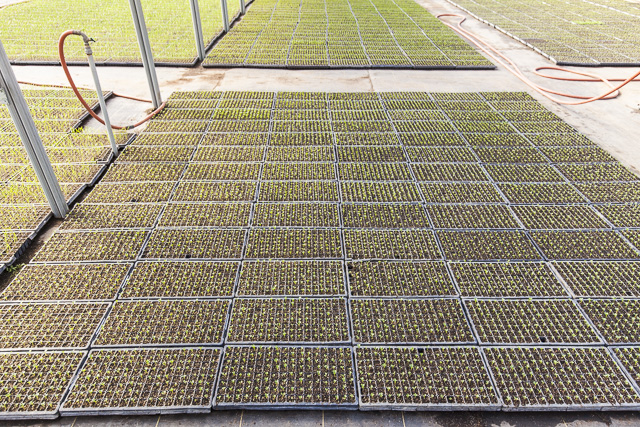
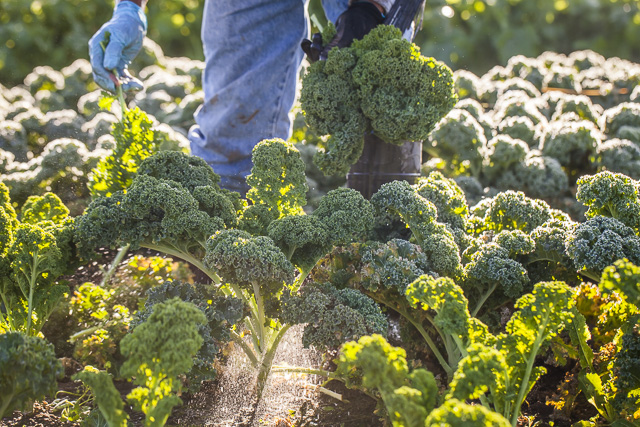 A dewy morning kale harvest. Photo by Scott David Gordon
A dewy morning kale harvest. Photo by Scott David Gordon
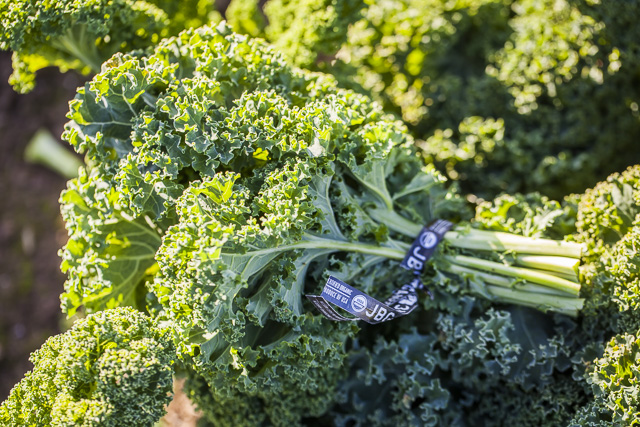 Kale. Photo by Scott David Gordon
Kale. Photo by Scott David Gordon
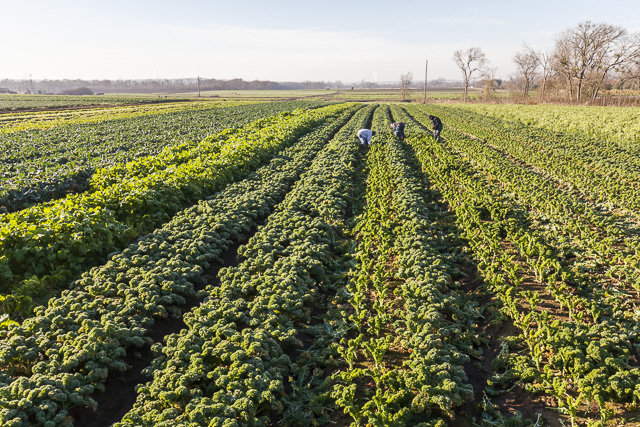 Who likes kale? Photo by Scott David Gordon
Who likes kale? Photo by Scott David Gordon
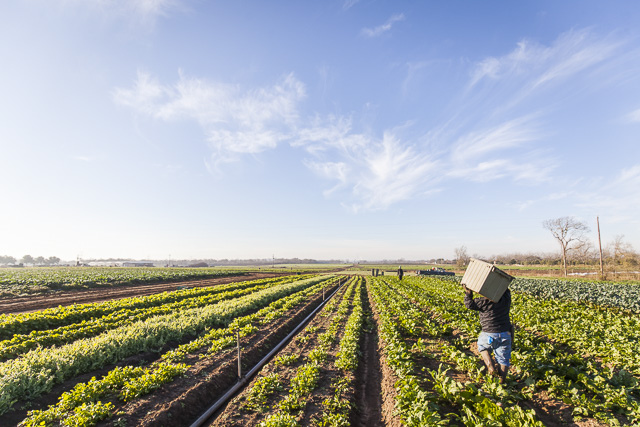 We've loved the blue skies in Austin this week. Photo by Scott David Gordon
We've loved the blue skies in Austin this week. Photo by Scott David Gordon
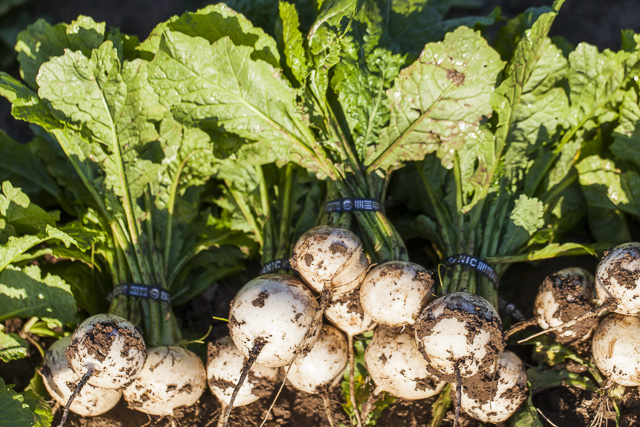 Hakuri turnips. Photo by Scott David Gordon
Hakuri turnips. Photo by Scott David Gordon
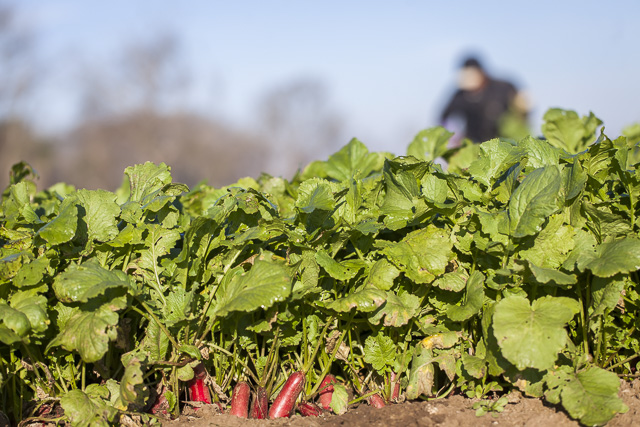 French breakfast radishes. Photo by Scott David Gordon
French breakfast radishes. Photo by Scott David Gordon
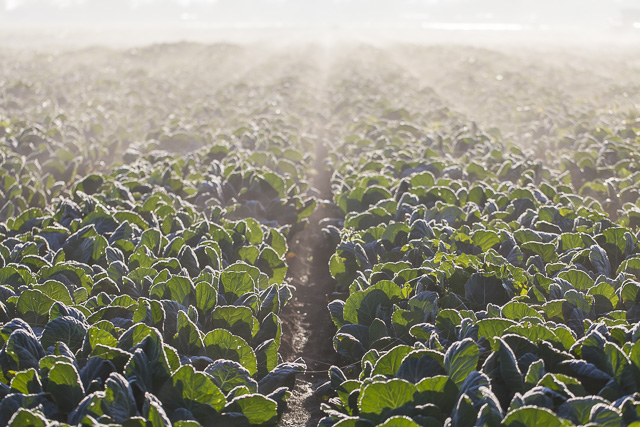 Scott photographs our collard greens on a frosty morning. Photo by Scott David Gordon
Scott photographs our collard greens on a frosty morning. Photo by Scott David Gordon
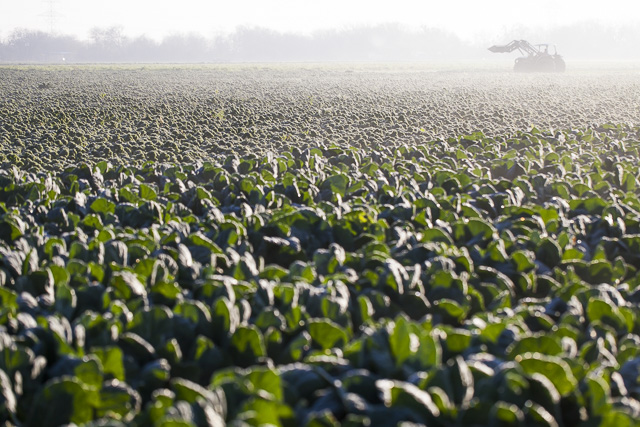 Photo by Scott David Gordon
Photo by Scott David Gordon
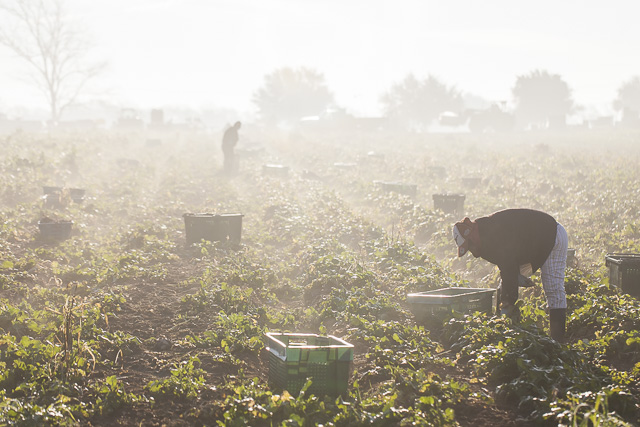 Misty morning harvest. Photo by Scott David Gordon
Misty morning harvest. Photo by Scott David Gordon
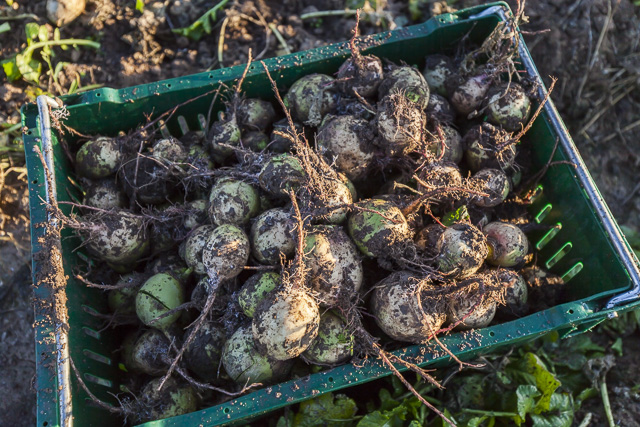 Watermelon radishes are a winter favorite. Photo by Scott David Gordon
Watermelon radishes are a winter favorite. Photo by Scott David Gordon
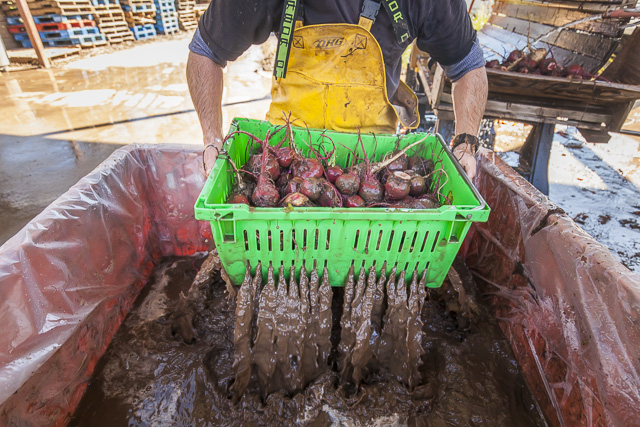 This is how we get your beets sparkly clean. Photo by Scott David Gordon
This is how we get your beets sparkly clean. Photo by Scott David Gordon
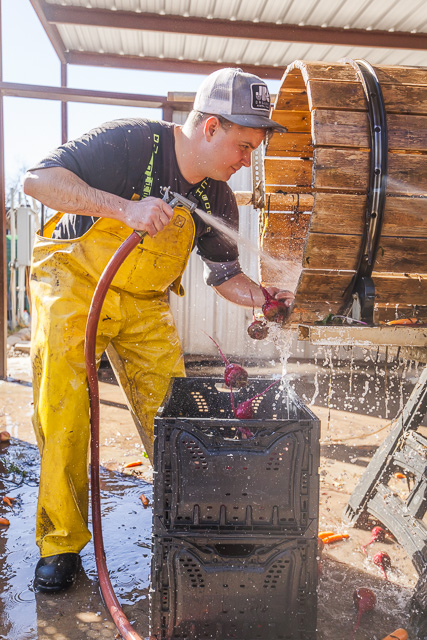 Doug sprays the chioggia beets. Photo by Scott David Gordon
Doug sprays the chioggia beets. Photo by Scott David Gordon
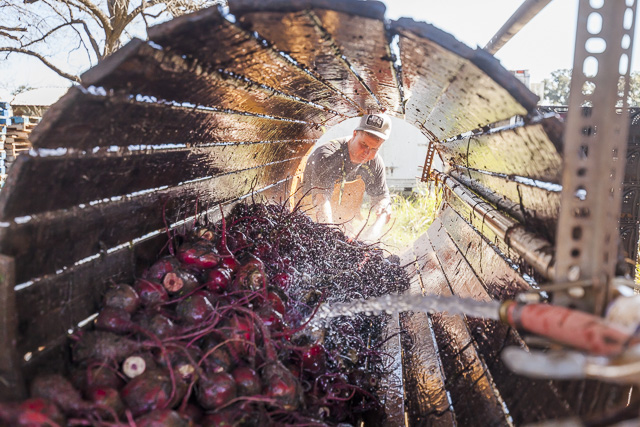 Washing chioggia beets in the barrel washer. Photo by Scott David Gordon
Washing chioggia beets in the barrel washer. Photo by Scott David GordonALL HAIL THE CARROT
01/15/16 — Farm
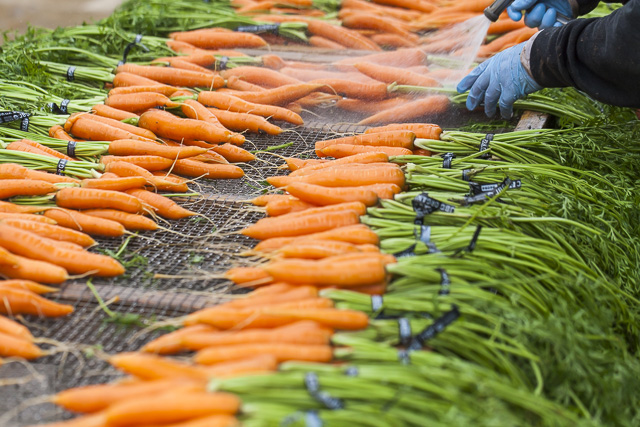
You like them. Your kids like them. Your farmers love em. We're eating carrots like they're going out of style at the farm these days, so this week on the blog, we wanted to shed a light on one of our favorite crops, Daucus carota. This crisp and crunchy taproot has a lot more to it than meets the eye (they're also great for your eyes), so read up, eat up, and enjoy!
Carrots: A Brief History
Wild ancestors of our modern-day carrots have been around for nearly 5,000 years. These carroty roots were woodier, bitter, and thinner than what we grow today, and grew wild in modern-day Afghanistan. And that bright orange root we're used to? Think again - the original carrots came in a variety of colors - purple and yellow were prominent, but black, red and white carrots were also consumed. You read that correct - no orange at all! As early farmers bred these plants for plumper and tastier roots, seeds were also traded to other growing civilizations - images of purple carrots adorn the tombs of some ancient Egyptian pharaohs!
 7th century depiction. Courtesy of the World Carrot Museum
7th century depiction. Courtesy of the World Carrot Museum
Carrots reached Europe by the 13th century, and were often prescribed as a medicinal plant, used as an aphrodisiac and for numerous ailments, including animal bites. By this time, the cultivated carrots were most often red, yellow, and purple, and closer in shape and size to the carrots we are familiar with today. The first appearance of an orange carrot was in the Netherlands in the 16th century, around the time that William of Orange led the Dutch revolt against the Spanish empire. Dutch carrot farmers had bred a hybrid of the carrot with a bright orange color due to high levels of beta-carotene, and with the formation of a new Dutch empire, the variety became wildly popular and widely grown in honor of the House of Orange (or so they say). Bet you never guessed your favorite veggie had a political agenda, did you?
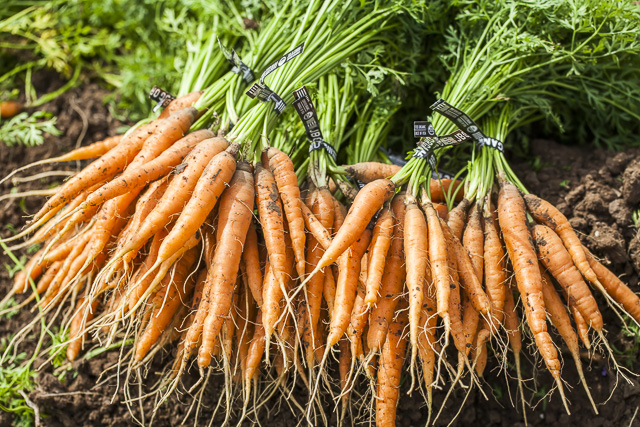
Why are they so important?
Aside from their beauty and great taste, carrots have a lot to offer to growers and consumers. They are quite the nutritional powerhouse - just 100g of carrots (or, 2 large carrots) contains over 100% of your daily vitamin A and is also a good source of vitamins K and B6 in only about 40 Calories! The carotenoids in carrots are potent antioxidants, helping your body fight damage on a cellular level.
From a farmers perspective, carrots are a wonderful crop. They thrive in cooler temperatures, are fairly resistant to pests and disease, and are a great storage crop. Farmers and homesteaders have relied on the storage life of carrots for hundreds of years, especially in colder climates, to keep their families fed during the cold months. Frosts increase the sugar content of carrots, which means that right now in Texas is one of the best times to be eating these tasty treats!
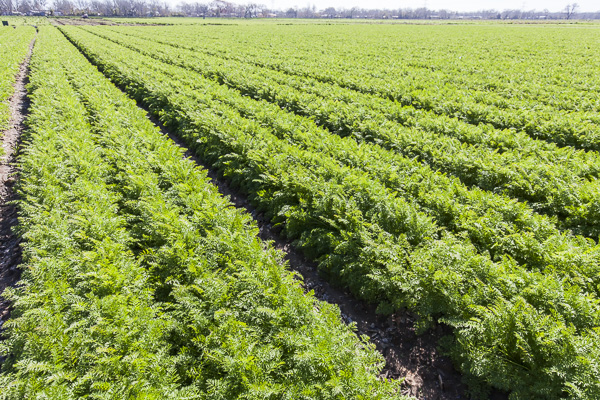
Fun facts:
- The Indo-European root ker- refers to the similarities in shape between a carrot and a horn (the originals were white, remember?)
- Carrots and parsnips were often called by the same name - the first record of a parnsip wasn't until 1753
- Mel Blanc, the voice of cartoon character Bugs Bunny, reportedly did not like carrots.
- Think "baby carrots" are just a fun mini variety? Think again.
JBG Carrots Around Town:
We've got two exciting carroty projects in Austin coming up. Our friends at Tacodeli have a very special taco release coming up this Tuesday. We can't talk details, but there might be a rainbow of a special root veggie in there. Stay tuned!
JBG's carrots are also going to be feeding Austin ISD students this semester. Today, students at Brooke Elementary will be eating locally grown, organic carrots on their salad bar. We hope to tune you in to future AISD features and want to thank them again for supporting their local farmers!
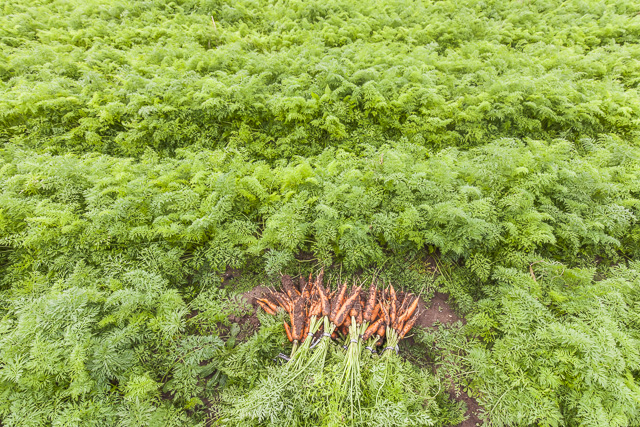
Things to Do with your Carrots:
- Roasted Honey Rosemary Carrots
- Carrot Black Bean Tacos with Carrot Top Chimichurri
- A Simple Carrot Soup
- Carrot, Sweet Potato, Almond Cookies
- Carrot Tangerine Turmeric Juice
...and things not to do with your carrots:
We don't recommend using your carrots to smuggle drugs. Creative, maybe, but what a waste of a good crop of carrots!
Now that we've told you what we have to say, it's your turn! What do you love about carrots, and what's your favorite way to eat them at home! Leave us a comment below!
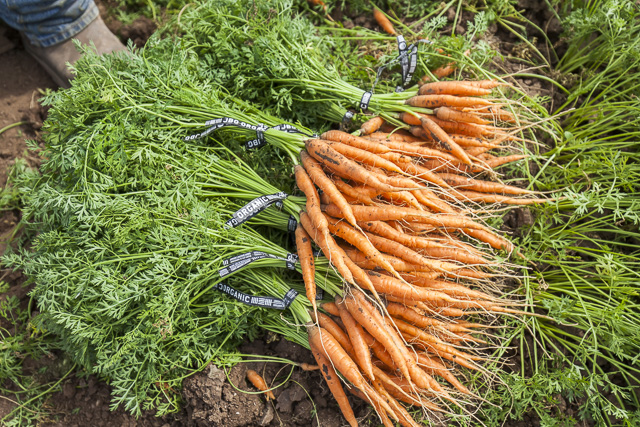
CSA BOX CONTENTS WEEK OF JAN 18TH
01/18/16 — Scott
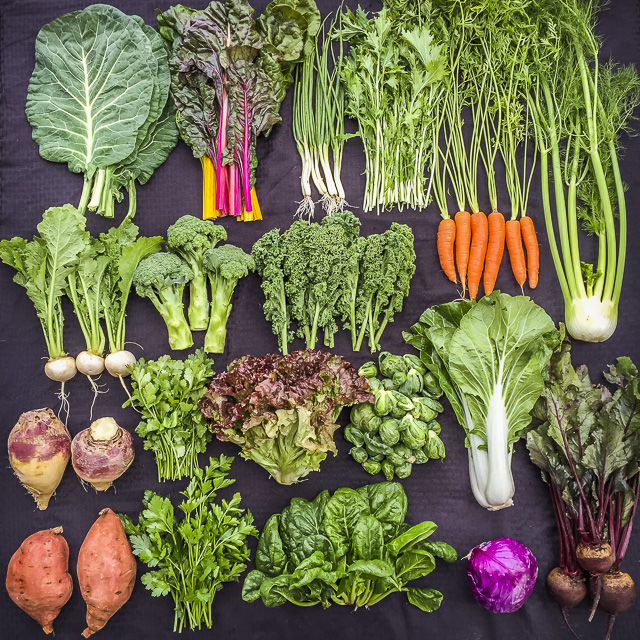 CSA Box Contents Week of Jan 18th
CSA Box Contents Week of Jan 18th
Beet, Red
Broccoli
Cabbage, Red
Carrot, Rainbow
Greens, Chard, Rainbow
Greens, Collards
Greens, Kale, Curly
Herb, Cilantro
Lettuce, Red Leaf
Onion, Spring Red
Potato, Sweet
Turnip, Rutabaga
Turnip, White Japanese
Beet, Red
Brussels Sprouts
Cabbage, Red
Carrot, Orange
Greens, Collards
Greens, Kale, Curly
Greens, Salad Mix
Herb, Cilantro
Onion, Spring Red
Potato, Sweet
Broccoli
Cabbage, Red
Greens, Kale, Curly
Greens, Salad Mix
Greens, Spinach
Onion, Spring Yellow
Potato, Sweet
Broccoli
Greens, Collards
Greens, Spinach
Potato, Sweet
Scallions
Turnip, White Japanese
CSA BOX CONTENTS WEEK OF JAN 18TH
01/19/16 — Scott
 CSA Box Contents Week of Jan 18th
CSA Box Contents Week of Jan 18th
Medium Box
Broccoli
Cabbage, Red
Carrot, Orange
Greens, Collards
Greens, Kale, Curly
Greens, Salad Mix
Greens, Spinach
Herb, Parsley, Flat
Scallions
Turnip, White Japanese
ZESTY KALE CHIPS
01/20/16 — Farm
 by Megan Winfrey
by Megan Winfrey
There are certain foods that never last long around our house. Cookies, and therefore milk, obviously. Grandma's Hummus, am I right? Wine, which isn't a food but totally counts as dinner. And Kale chips, which I'm unsure if my husband has even tried because I've consumed every single one I've ever made within the hour. When done right, these airy, crispy, robustly flavored little treats are so heavenly, you'll want to lick the pan you baked them on.
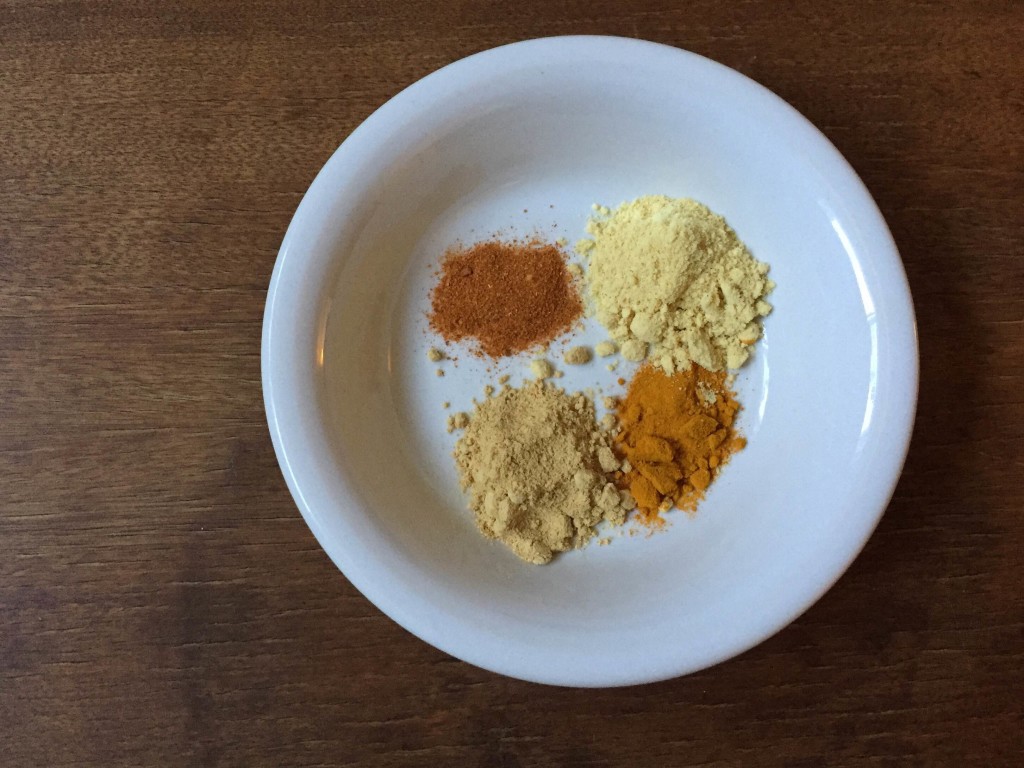
Zesty Kale Chips
- 1 bunch of Dino Kale, washed, stems removed
- 3 tbs. olive oil
- 1 tbs. ginger
- 1 tbs. mustard powder
- 1 tsp. turmeric
- 1/2 tsp. cayenne
- 1/2 tsp. salt
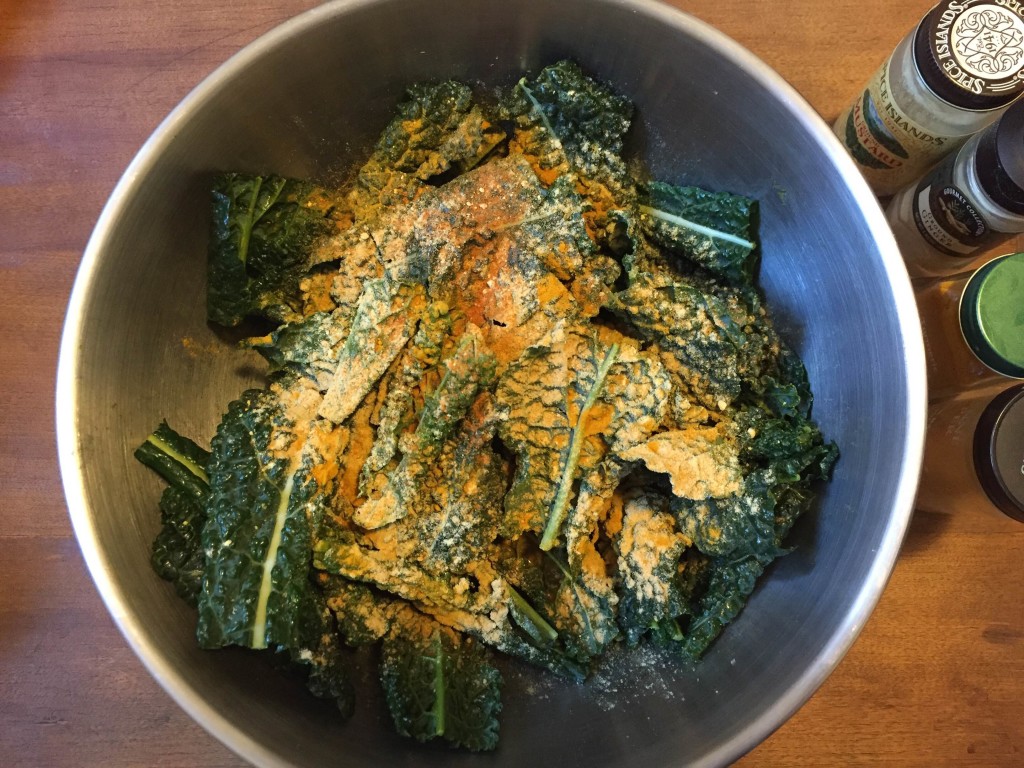 Cut the kale leaves into halves or thirds, depending on the size of the leaf. Transfer them to a large bowl. Add the olive oil and spices and massage thoroughly into the kale leaves. Try to distribute the spices as much as you can.
Cut the kale leaves into halves or thirds, depending on the size of the leaf. Transfer them to a large bowl. Add the olive oil and spices and massage thoroughly into the kale leaves. Try to distribute the spices as much as you can.
On 2 large sheet pans, line up the kale leaves so that they are close together, but not touching. They will crisp up very nicely as long as they aren't touching at all. Sprinkle evenly with salt, then bake for 50-60 minutes, until they are paper thin and will crumble if pressed down. Let cool, store in an airtight container, and try to save some for your loved ones.
WEEK 3 IN PHOTOS
01/22/16 — Farm
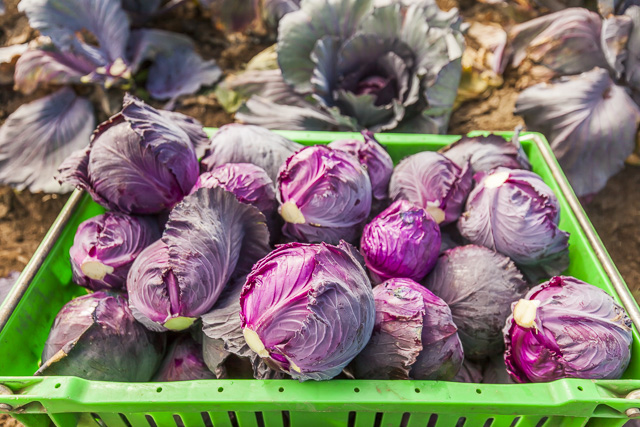 Harvesting red cabbage. Photo by Scott David Gordon
Harvesting red cabbage. Photo by Scott David Gordon
We are loving this warmer winter 2016 has brought! We're starting to plant for the spring season, putting in the first succession of cabbage, kale, leeks, broccoli and more. The greenhouse is bustling with activity, both seeding for the farm and for our Spring Transplant Sale, beginning March 5th. In the office, we're interviewing for new employees (check out our Jobs page to join the team at JBG!) and scheduling lots of citrus for new CSA members (haven't signed up yet? Our New Year's special for free citrus is still running!!)
As always, Scott has captured Week 3 in a beautiful set of images to share with you.
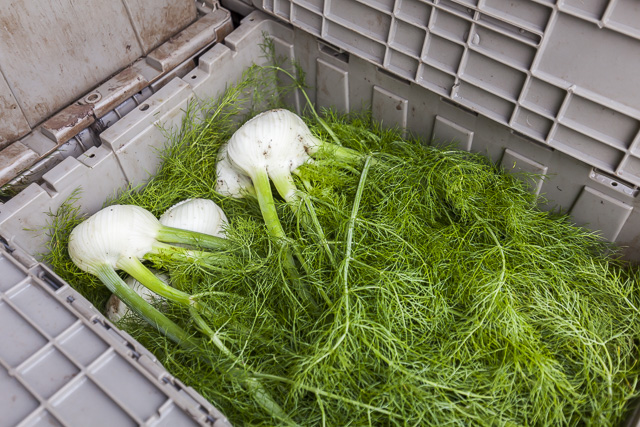 Fragrant bins of fennel. Photo by Scott David Gordon
Fragrant bins of fennel. Photo by Scott David Gordon
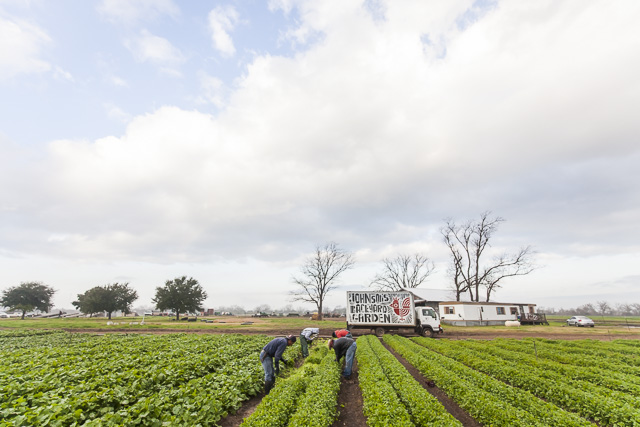 The blue skies have been absolutely beautiful at our Garfield Farm this week. Photo by Scott David Gordon
The blue skies have been absolutely beautiful at our Garfield Farm this week. Photo by Scott David Gordon
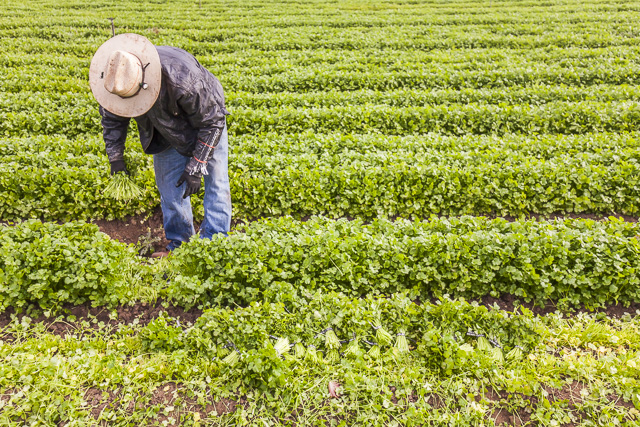 Harvesting cilantro. Photo by Scott David Gordon
Harvesting cilantro. Photo by Scott David Gordon
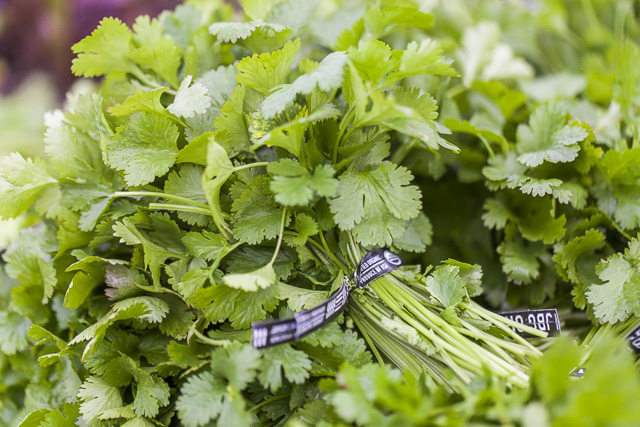 Photo by Scott David Gordon
Photo by Scott David Gordon
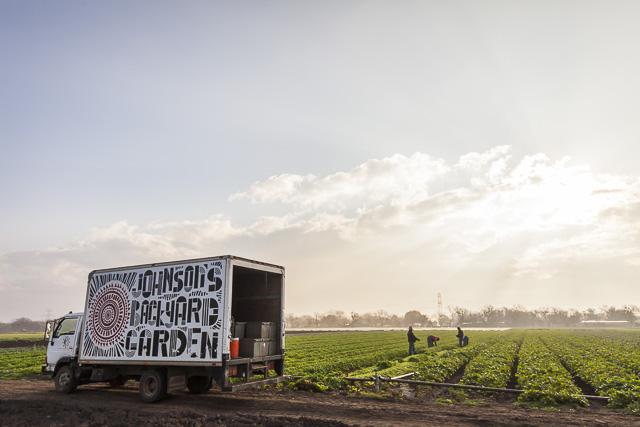 Photo by Scott David Gordon
Photo by Scott David Gordon
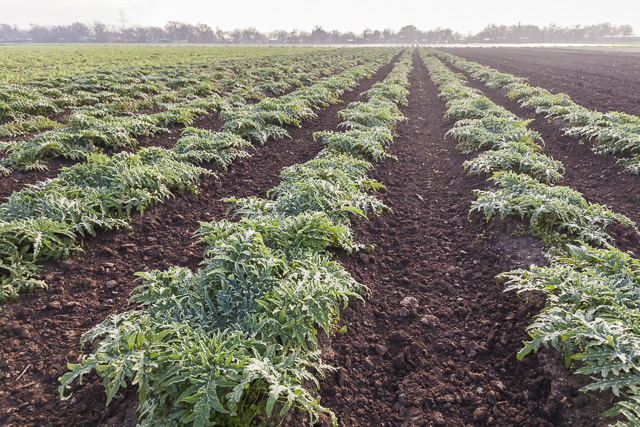 Artichokes are coming along! Photo by Scott David Gordon
Artichokes are coming along! Photo by Scott David Gordon
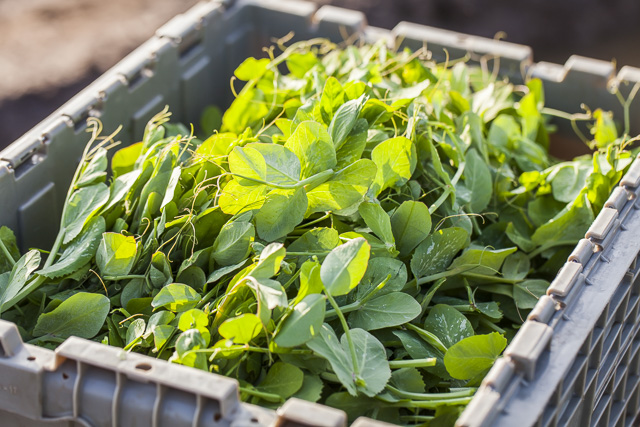 Pea tendrils are a sweet winter treat. Photo by Scott David Gordon
Pea tendrils are a sweet winter treat. Photo by Scott David Gordon
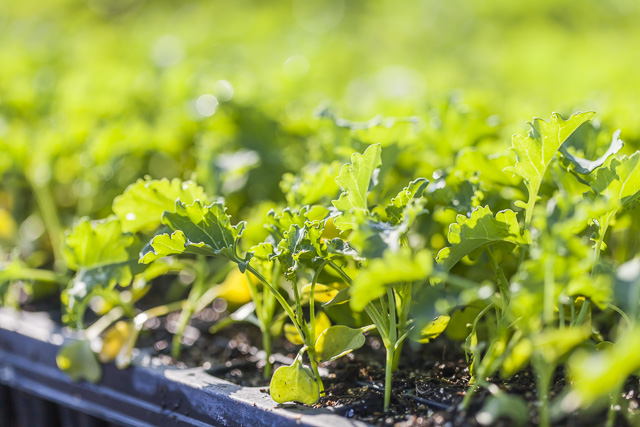 Our first succession of curly kale was transplanted this week. Photo by Scott David Gordon
Our first succession of curly kale was transplanted this week. Photo by Scott David Gordon
 JBG's bed shaper in action. Photo by Scott David Gordon
JBG's bed shaper in action. Photo by Scott David Gordon
 Photo by Scott David Gordon
Photo by Scott David Gordon
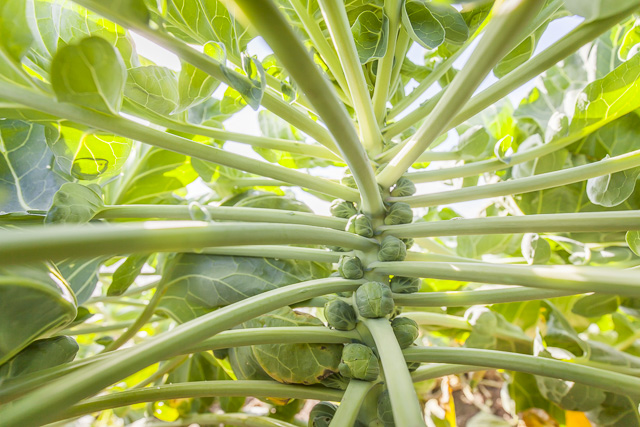 Brussels sprouts fresh on the stalk. Photo by Scott David Gordon
Brussels sprouts fresh on the stalk. Photo by Scott David Gordon
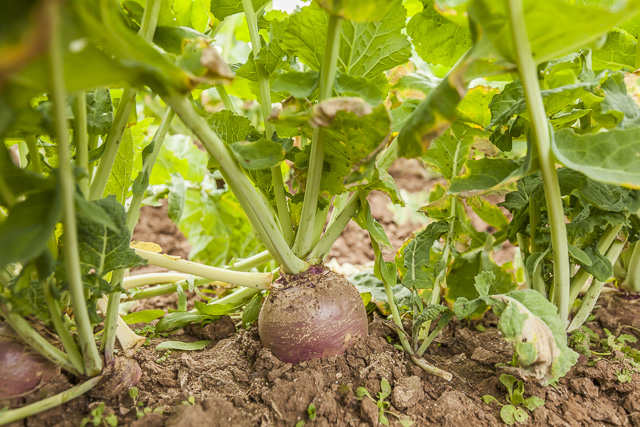 Rutabaga. Photo by Scott David Gordon
Rutabaga. Photo by Scott David Gordon
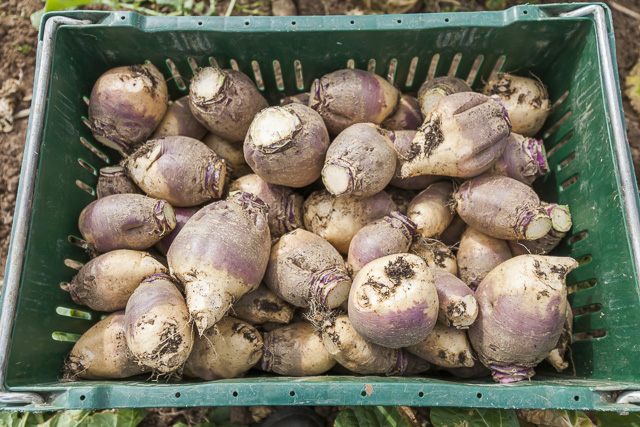 Not the most beautiful crop, but they sure are tasty! Photo by Scott David Gordon
Not the most beautiful crop, but they sure are tasty! Photo by Scott David GordonJBG'S ANNUAL TRANSPLANT SALE STARTS MARCH 5TH!
01/22/16 — Farm
 See you on February 27th for the annual Transplant Sale! Photo by Scott David Gordon
See you on February 27th for the annual Transplant Sale! Photo by Scott David Gordon
Are you starting to prepare your garden beds for Spring? We sure are! We've started seeding like crazy for what's sure to be the best spring yet at the farm, and we want to help your backyard garden thrive too.
Our annual Transplant Sale starts on March 5th. We'll have all of the certified organic, locally grown transplants you need to grow a flourishing garden. The Transplant Sale will be at our Garfield Farm, 4008 River Rd., Garfield, TX 78612 and will run for two weekends. We also have a special pop-up market planned - stay tuned for the details!
EMPLOYEE SPOTLIGHT: ASSISTANT FARM MANAGER JASON
01/22/16 — Farm
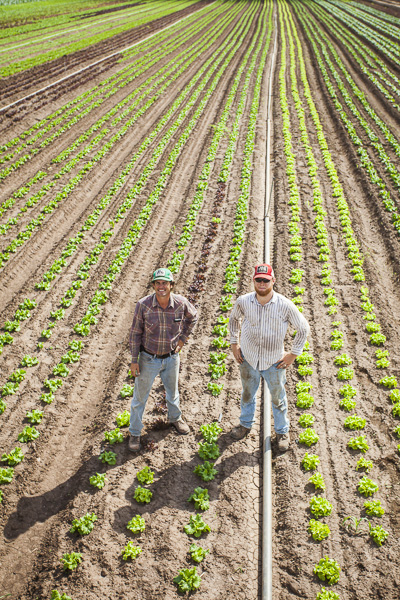 Brenton and Jason in a lettuce patch. Photo by Scott David Gordon
Brenton and Jason in a lettuce patch. Photo by Scott David Gordon
We are kicking off a series of employee spotlights to introduce you to some of the people behind the scenes who are responsible for filling your fridge each week. We hope this series will give you a little more insight about the planning, growing, harvesting, packing, and delivery of JBG's organic veggies around Texas. Today we're showing off our Assistant Farm Manager, Jason Hamelwright - Jason has been with the farm for just over 3 years and is an invaluable asset to our team. Community - meet Jason!
Jason has been around JBG for a while now. In 2012, he was a regular workshare at our Garfield Farm. We hired him first as farm driver, transporting all of our harvests between the field and the packing shed. Jason then became our Garfield Farm workshare coordinator, then a field coordinator and farm administrator, and most recently has taken on the huge job of assistant farm manager! We interviewed Jason this week to learn more about his experience at JBG and what he's doing when he's not working on the farm.
Where did you grow up, and what brought you to JBG?
My family moved around Texas growing up, but I spent most of my early years just outside of Victoria, TX near the coast. I lived with family in the Dallas area for a bit, and eventually moved with my wife to Belton to attend school. I was in a tech field, and she was studying nursing, so after school we moved to the Austin area to find good work. I had lived here for a time growing up, and coming back felt like I was moving home. I can't really explain why it felt that way - it was insignificant little things like the stickerburrs that grow here, but not on the coast, that just seemed right.
In 2011, I was a freelance developer, building a website that was sort of a food research hub. I loved eating at local restaurants and wanted there to be a resource for consumers to find out where all of the ingredients came from - who grew them, how they were grown, etc. Before I started talking about local food, I figured I should have some experience growing it. So I visited the Cedar Park Farmers Market, found the JBG workshare program, and started volunteering. Before long, I was bugging the field coordinator for a job, and was hired on in the farm driver position.
I figured I'd give it a year - I never imagined that I would be here 3 years later. But after realizing how much enjoyed both the hard labor and constant problem solving, it became apparent that farming is a great fit for me.
 Jason as farm driver.
Jason as farm driver.
What is your current role at JBG?
As assistant farm manager, I do a little bit of everything. Right now, most of the work is crop planning for the year ahead. I try to take the requests of all of the managers (CSA, farmers markets, wholesale, field crew, Brenton) for what they would like to see grown this year. It's my job to respect everyone's needs, and also to apply priorities and sensibility with my knowledge of the workings of the farm, to create a field plan that best suits the goals of the company.
Once this plan is made, I work hand in hand with our greenhouse manager to make sure transplants are ready in time, with the field crew to make sure they know what beds need to be prepared and have all the resources they need to do it, as well as working with drivers, mechanics, and managers to coordinate what happens post-harvest - basically, Imake sure all of the pieces of the puzzle are fitting together properly.
What drew you to agriculture and local food systems?
One thing I love most about this field is the community building that grows from the farm. Within the farm, we have a community of hard working team members, both in the field and out. You have to have some serious work ethic to gain the respect of those around you, and our relationships on the farm are really strong because we do work so hard together for a shared goal. Outside the farm, I see a great community who is working together to help change the trend of modern-day diets towards a healthier alternative. This is really important when I look around and see how our diet has changed in the past few decades, so I'm glad to be a part of the solution.
 Jason with his sons.
Jason with his sons.
What does your life look like off the farm?
Off the farm, I'm a huge family guy. I have two sons - Derrick, who is 2 1/2 years old, and Lucas, who is just 1 month. My wife and I love to go out to eat at local restaurants, but with a growing family it's been hard to find time and energy to do so. I love listening to music and podcasts at home, while I either cook, clean or fix things around the house. I also spend a lot of time playing with my sons - Derrick loves spending time outside with his dad, building a garden, kicking a ball around, or playing with the mountain of toys that the grandparents have bestowed on us.
What's cooking in your kitchen these days?
In the winter, one of my favorite meals is to get a big roast in a pan with all of the winter vegetables - carrots, onions, even radishes and fennel cut into big chunks. I add oregano, rosemary and thyme from my garden along with some hardy winter greens and roast them all together.
On the weekends, I'm a barbecue guy. I like to grill just about every vegetable out there, though I am still trying to figure out the best way to grill sweet potatoes without wrapping them up in foil. Our family loves to put ribs, lamb, or steak on the grill along with all of the veggies in our CSA box and enjoy some time outside.
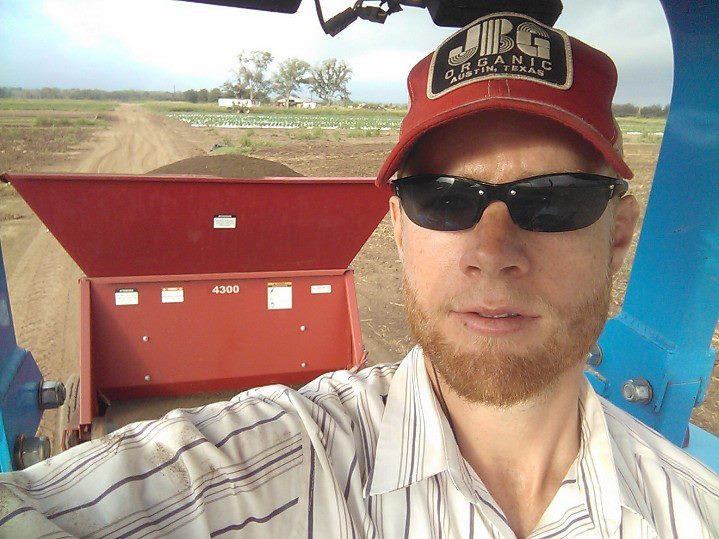
What might people be surprised to learn about you?
I've got an artsy side to me that comes out in various ways. I love to try my hand at amateur photography! I have a pretty nice camera and try to find opportunities to use it whenever I can. I also play guitar and trumpet, have a graphics design degree, and have edited film documentaries and loved it.
Favorite and least favorite crops?
I don't really think I like or dislike any crops more than others, they are all part of the farm system and I like growing them all. (After some prodding:) I really love the looks of a field of lettuce - the long rows of different colors are very visually appealing. Although I really like zucchini, especially on the grill, last year we had a lot of trouble growing it due to some weather issues and bad spacing. I wouldn't say it's my least favorite though - it's just a problem that we get to try and solve this year.

Staff Survey: If Jason were a veggie, which one would he be, and why?
Ada, Brenton, Nellie: A carrot! He's sensible, versatile, and well-liked by everyone. He's hardy and can deal with lots of personalities, weather disasters, and a newborn with grace and humility. Carrots are used across many different cuisines, and Jason works very well cross-culturally too. He's tall and lanky like a carrot, and there's more beneath the surface than you might guess at first glance.
Krishna: Armenian cucumber. He's long and skinny, and can remain cool when the heat is on!
Temo: Daikon radish - he's very tall and white.
Kate: Butternut squash. He's got a tough and rigid exterior but under the right conditions is very soft and sweet.
CSA BOX CONTENTS WEEK OF JAN 25TH
01/26/16 — Scott
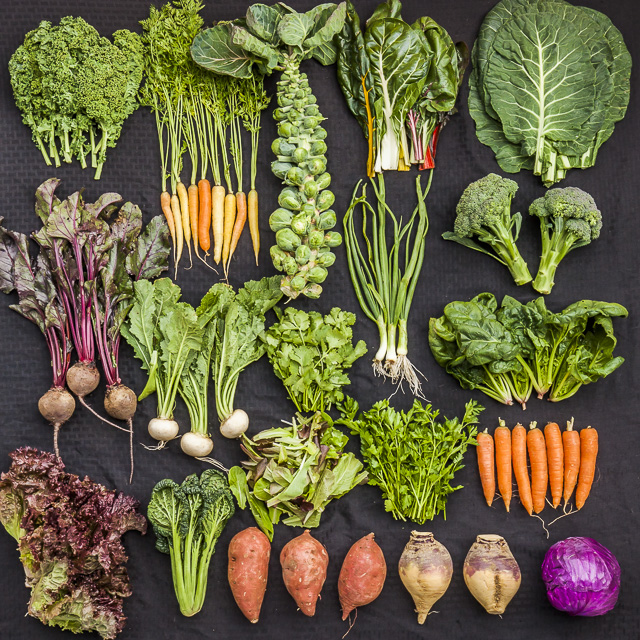 CSA Box Contents Week of Jan 25th
CSA Box Contents Week of Jan 25th
Beet, Red
Bok Choy
Broccoli
Brussels Sprouts
Carrot, Orange
Greens, Chard, Rainbow
Greens, Kale, Curly
Greens, Salad Mix
Greens, Spinach
Herb, Cilantro
Onion, Spring Yellow
Potato, Sweet
Turnip, White Japanese
Beet, Golden
Bok Choy
Brussels Sprouts
Carrot, Orange
Greens, Kale, Curly
Greens, Spinach
Herb, Cilantro
Lettuce, Mixed head bag
Onion, Spring Yellow
Potato, Sweet
Beet, Red
Brussels Sprouts
Carrot, Orange
Greens, Arugula
Greens, Collards
Greens, Spinach
Herb, Parsley, Flat
Beet, Red
Brussels Sprouts
Carrot, Orange
Greens, Kale, Curly
Greens, Salad Mix
Herb, Fennel
CSA BOX CONTENTS WEEK OF JAN 25TH
01/26/16 — Scott
 CSA Box Contents Week of Jan 25th
CSA Box Contents Week of Jan 25th
Medium Box
Beet, Red
Brussels Sprouts
Cabbage, Red
Carrot, Orange
Greens, Collards
Greens, Kale, Curly
Greens, Salad Mix
Herb, Cilantro
Onion, Spring Red
Potato, Sweet
VEGETABLE SPRING ROLLS
01/27/16 — Farm

by Megan Winfrey
Trying to incorporate more raw foods into your diet? There's really no better way to benefit from the organic produce we receive each week than to eat it raw. Cooking leeches out vital nutrients - even a light steam takes out some of the good stuff. This is, by far, is my favorite way to eat raw veggies (dipped in Grandma's Hummus comes in close second). Fun to make and so versatile, you're gonna love experimenting with your own versions of this recipe.
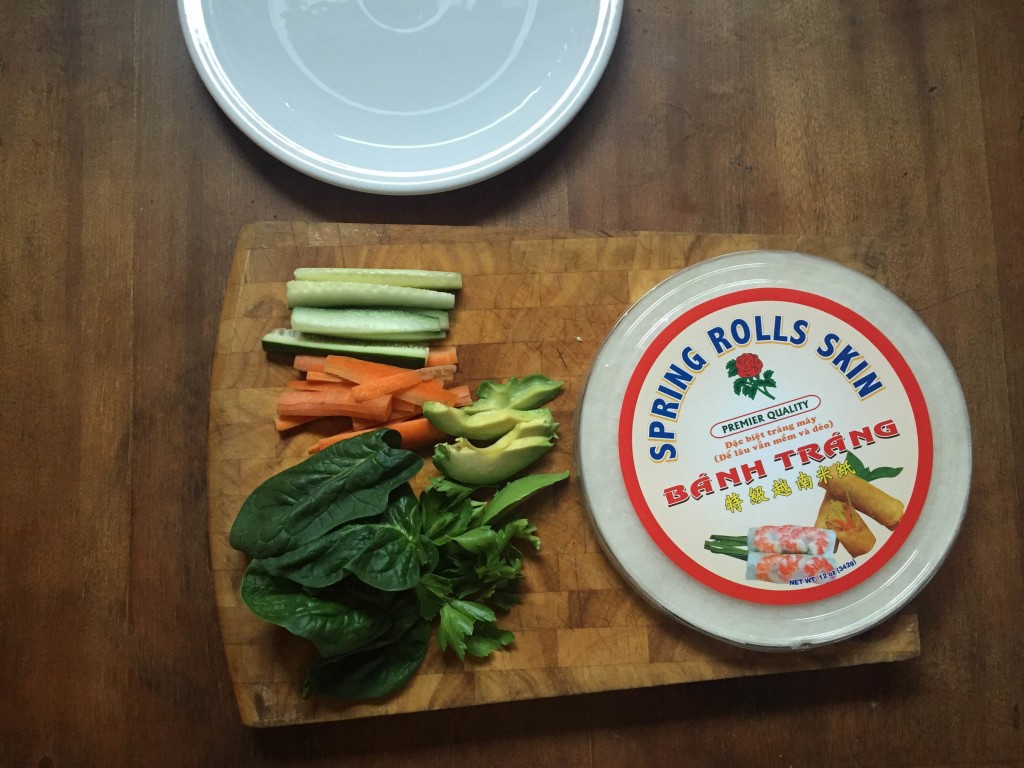
Vegetable Spring Rolls
- 10 leaves of spinach
- 12-15 leaves of parsley
- 2 carrots, julienned
- 1 cucumber, julienned
- 1 avocado, sliced
- 1 pack of spring roll paper
Recipe for peanut sauce which you probably have the ingredients for in your pantry.
Fill a dinner plate with water, as close to the edge as you can. Carefully put on a flat surface with plenty of space around you for assembly. Gather all of the ingredients, keeping everything at arm's length. To prepare the paper for wrapping, submerge one paper at a time into the plate of water. Flip and submerge the other side. The paper will still feel stiff, but will soften up while you assemble the vegetables.
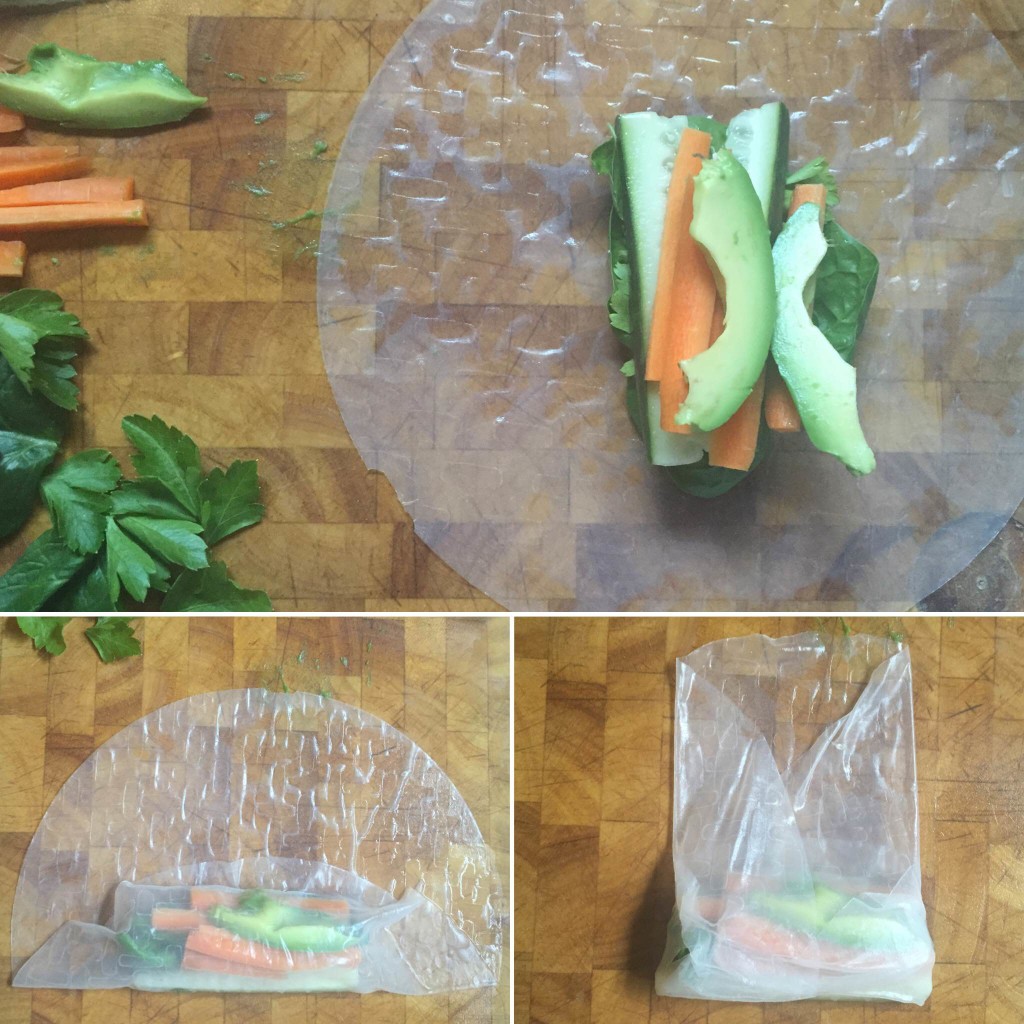
Lay out the paper and mound the veggies in the center. Really pile them on if you want to, the paper will stretch and stick to cover it all. I am a fan of the burrito method of folding, which I outlined in photographs. Basically, fold one side over and tuck under the veggies. Fold up the sides to meet the center, then roll. The paper should be thin and very sticky.
Literally, that's it! Dip in delicious peanut sauce, Bragg's, stir fry sauce, hummus, salsa, whatever!
Don't you just love when impressive cooking is simple?! And, actually isn't even cooking at all!
WEEK 4 IN PHOTOS
01/29/16 — Farm
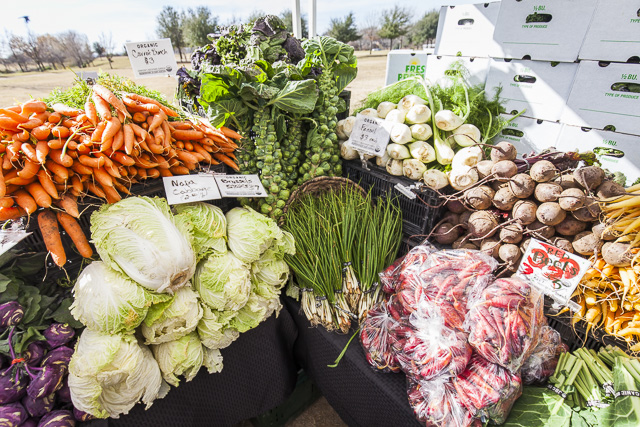 Markets have been incredibly bountiful - we are grateful for the warm weather this winter! Photo by Scott David Gordon
Markets have been incredibly bountiful - we are grateful for the warm weather this winter! Photo by Scott David Gordon
Another beautiful week at the farm, and another great set of photos from farm photographer Scott David Gordon! We spent another busy week finalizing crop plans, filling up our greenhouse, and transplanting the first of the spring crops in the field (with a little pause in the transplanting for a heavy mid-week freeze). Enjoy the photos from Week 4!
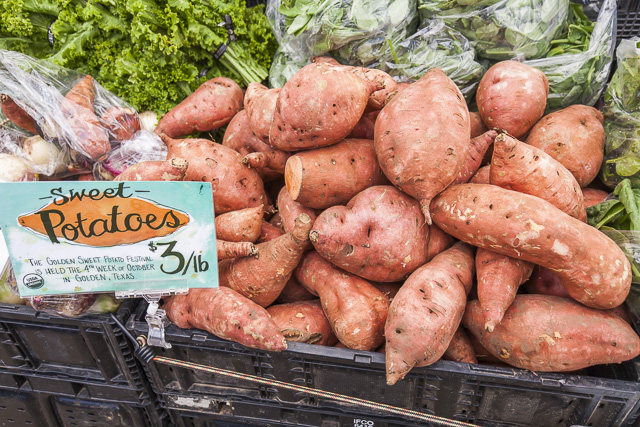 Photo by Scott David Gordon
Photo by Scott David Gordon
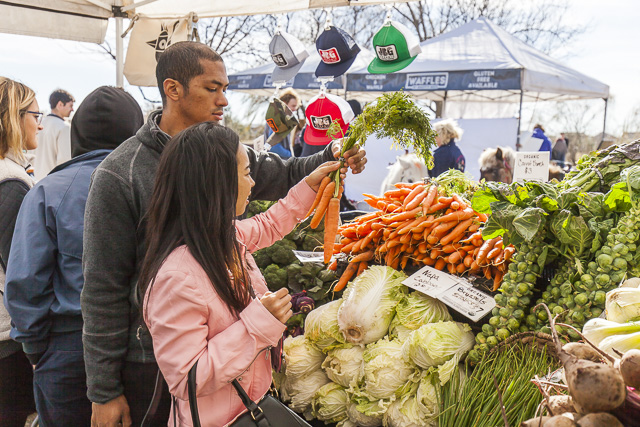 Photo by Scott David Gordon
Photo by Scott David Gordon
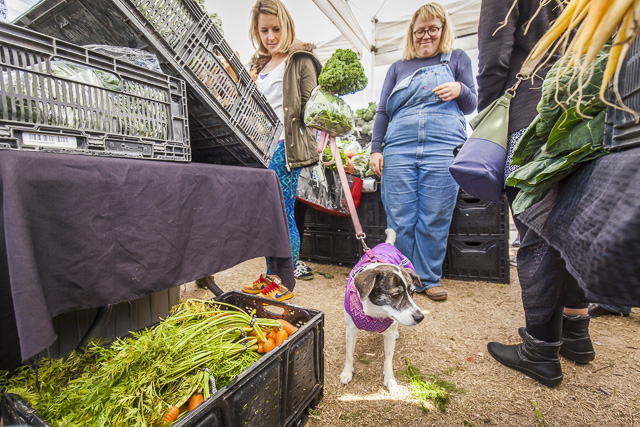 A friendly four-legged friend at Mueller Farmers Market. Photo by Scott David Gordon
A friendly four-legged friend at Mueller Farmers Market. Photo by Scott David Gordon
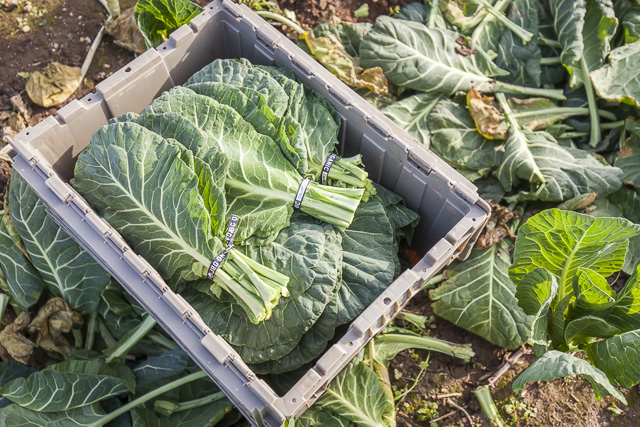 Collards. Photo by Scott David Gordon
Collards. Photo by Scott David Gordon
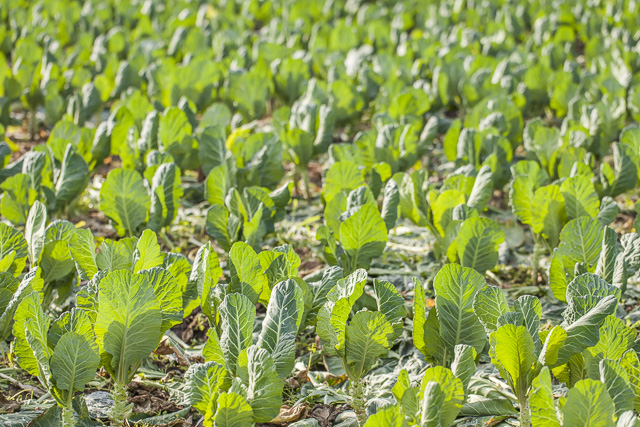 Collard rows post-harvest. Photo by Scott David Gordon
Collard rows post-harvest. Photo by Scott David Gordon
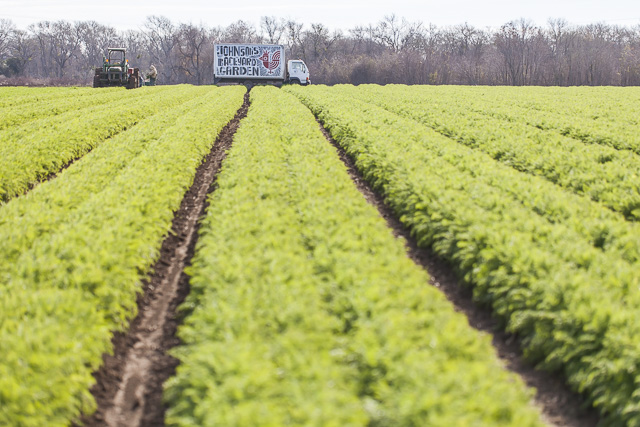 Photo by Scott David Gordon
Photo by Scott David Gordon
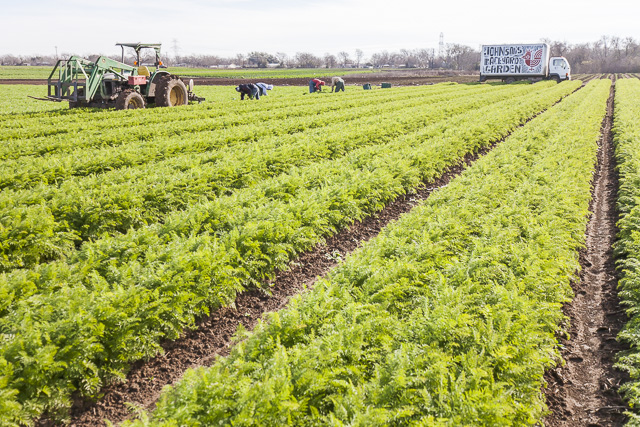 You guessed it - more carrots!
You guessed it - more carrots!
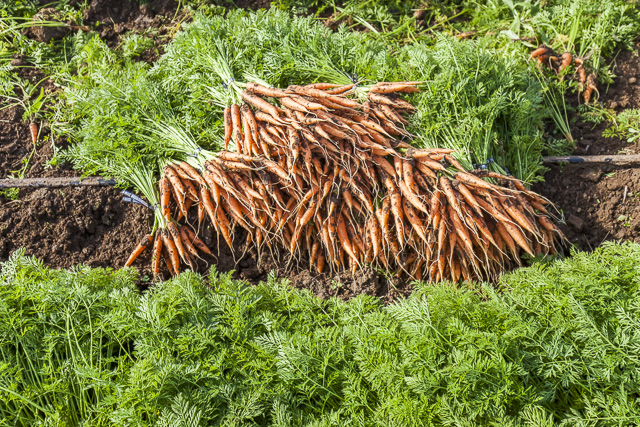 More of our favorite carrots. Photo by Scott David Gordon
More of our favorite carrots. Photo by Scott David Gordon
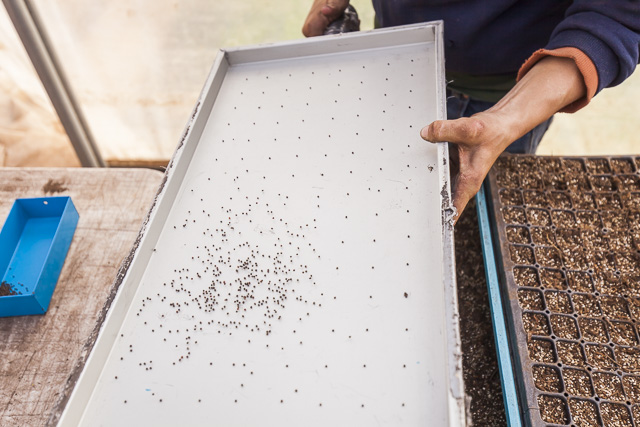 Kale for spring. Photo by Scott David Gordon
Kale for spring. Photo by Scott David Gordon
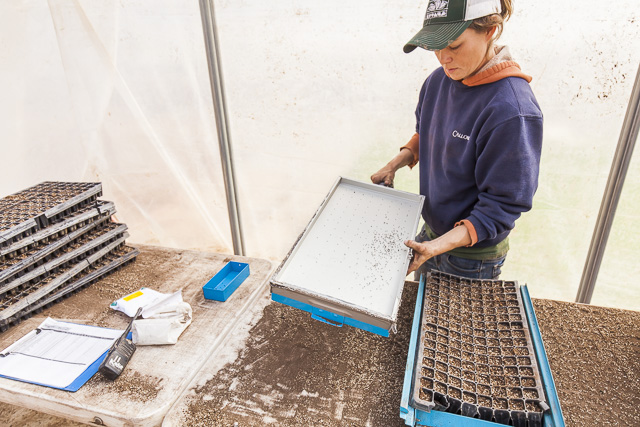 Katie shows Scott our vacuum seeder. Photo by Scott David Gordon
Katie shows Scott our vacuum seeder. Photo by Scott David Gordon
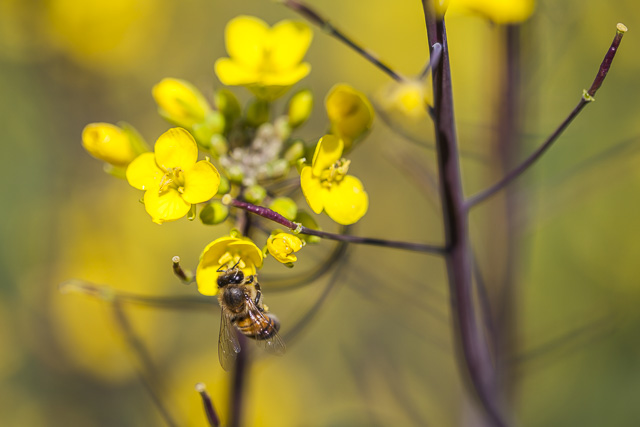 The honeybees we're busy this week, and we saw lots of pollen-laden ladies flying around the farm. Photo by Scott David Gordon
The honeybees we're busy this week, and we saw lots of pollen-laden ladies flying around the farm. Photo by Scott David GordonALWAYS IMPROVING
01/29/16 — Farm
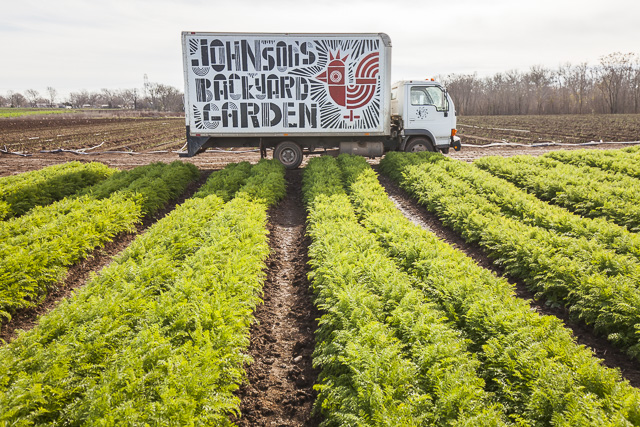 Photo by Scott David Gordon
Photo by Scott David Gordon
From the Farmer's Perspective
One of the things that motivates me to farm is the need for continuous improvement. When I do the same things all the time, I lose interest, so luckily I've found myself in a job where nothing stays the same for long. I'm the kind of guy who is full of ideas - my staff can tell you, sometimes I drive them crazy with the timing and frequency of them. But 2015 was a hard year for the farm. With two major flood events, my focus has been determinately set on problem solving in the present - salvage, recover, replant - instead of the future. This week was a step back into my old self though - I busted into Krishna's office twice with aha! moments and now I feel ready to dive into 2016 full on.This week I'm talking about some of the things we design behind the scenes to make sure your veggies show up each week.We're making some serious improvements right now at the farm - take our harvest management system, for example. Every day at JBG, there are harvest needs in four very different departments - CSA, farmers markets, restaurant sales, and wholesale accounts - that need to be picked, sorted, packed, and delivered, usually within 24 hours. Two years ago, every department manager would individually call or text Vicente, our harvest manager, with their orders! Vicente would sit in his "office" (pickup truck) on the phone the whole day, keeping track of these numbers in his notebook. Talk about inefficient.
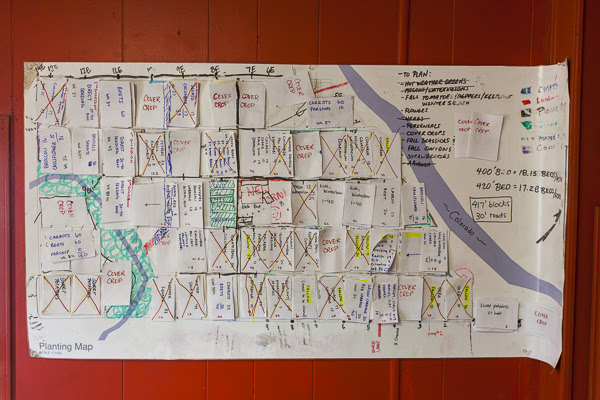 We have to do a lot of planning at JBG, from field plans to harvest management, and more, to ensure our complex system runs smoothly.
We have to do a lot of planning at JBG, from field plans to harvest management, and more, to ensure our complex system runs smoothly.
Then, we moved to an electronic system designed by employee Mike Reed. Mike, who is a spreadsheet wizard, took ALL of the information needed from each department and turned it into one monster of an Excel spreadsheet that consolidated and recorded numbers for harvest. As you can imagine, this spreadsheet was as complicated as the system it was designed for. It was a huge improvement - for Vicente, our managers, and for on-farm record keeping. But the spreadsheet had it's drawbacks as well - managers were exceptionally good at breaking it, putting numbers in the wrong places, or replacing code with fixed values. Mike was the only one who knew the spreadsheet in and out, and so was the only one with the knowledge to fix it! I knew something had to change.
One principle that has guided me in my years of farming is the K.I.S.S. Principle - Keep It Simple, Stupid. We couldn't keep relying on a spreadsheet that was too complicated for our managers to effectively use. So, with the help of Krishna and his amazing wife (who happens to be a great coder), we've implemented a new harvest management system this year. It's simple, easy to use, has a friendly interface, and most importantly - has precautions against people trying to break it! We used all of the lessons learned in our first harvest management spreadsheet, keeping only what we needed to effectively communicate with everyone on the team. Keep it simple, stupid. The JBG staff has been really happy with the changes, and I've seen awesome improvements! For example, with the new system, our farmers market managers have input to tailor each farm stand to the customers that shop at that particular location - cool, right?
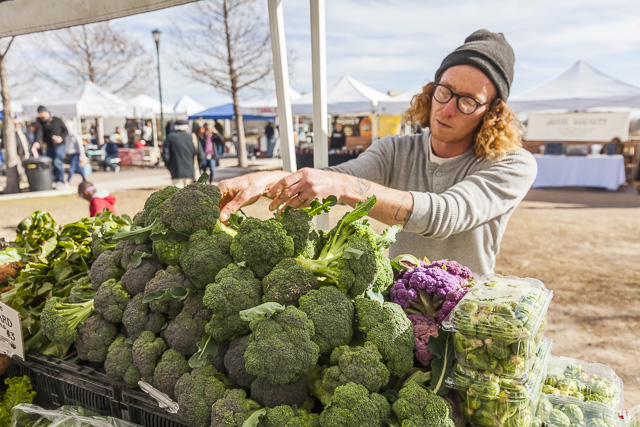 Our market managers will now have be able to customize their markets to fit their customers! Photo by Scott David Gordon
Our market managers will now have be able to customize their markets to fit their customers! Photo by Scott David Gordon
The next big improvement I'm looking forward to is creating a detailed look into every crop - labor costs, yields, sales, everything we need to know exactly which crops are profitable and which we still need to work on to get them there. One of my most read authors is Richard Wiswall - he's an expert on farm profitability and appropriate business tools and someone I look up to very much. I think it's important as a farmer to make sure that my teams aren't killing themselves to grow things that just don't work for us, and I'm excited to learn about all of our crops in depth.
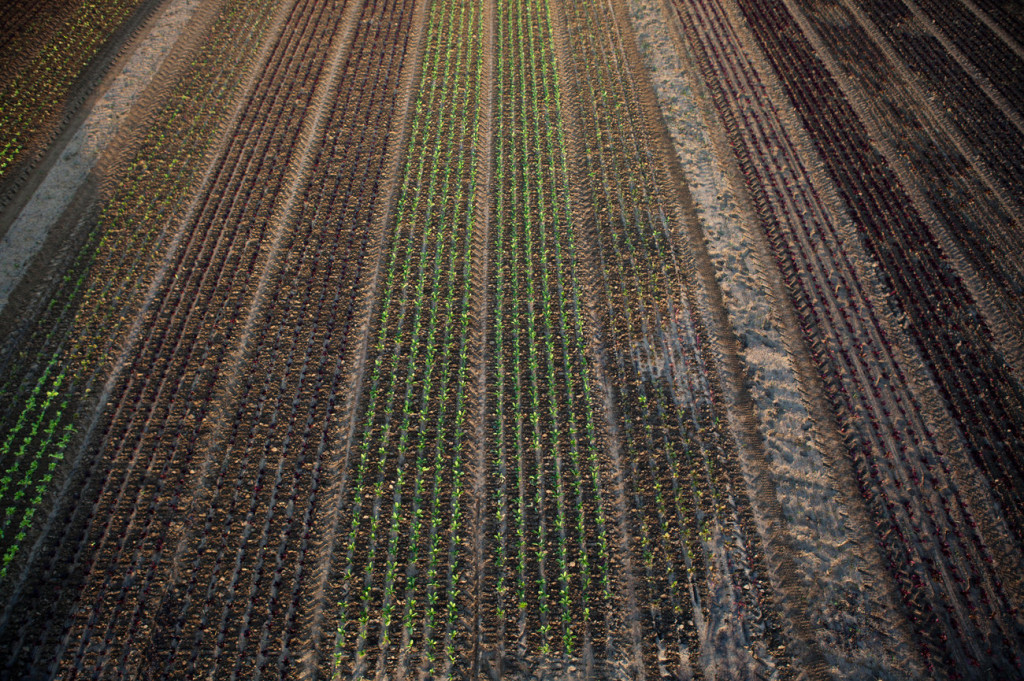 Chef's Garden in Huron, OH (Ryan Kellman/NPR)
Chef's Garden in Huron, OH (Ryan Kellman/NPR)
This may not sound interesting to someone who isn't a full-time farmer, so let me try to put it into perspective. I really enjoyed reading this NPR article this week about the Chef's Garden in Huron, Ohio. These guys are some of my farmer heroes, and what they are doing for the land and their customers is just awesome. You might read this article, look through the pictures, and see a beautiful farm growing specialty crops. I see a whole lot more - I see three generations of farmers who have been working for at least as long on improving their farm processes. They are doing everything they can to produce the best soil, and the best veggies on that soil. And they know exactly what the costs are to grow food in this very special manner - the article notes that prices from the Chef's Garden are about 2.5 times more than a regular production system. They aren't short-changing their efforts and they sell to customers who know what they are getting for their money.
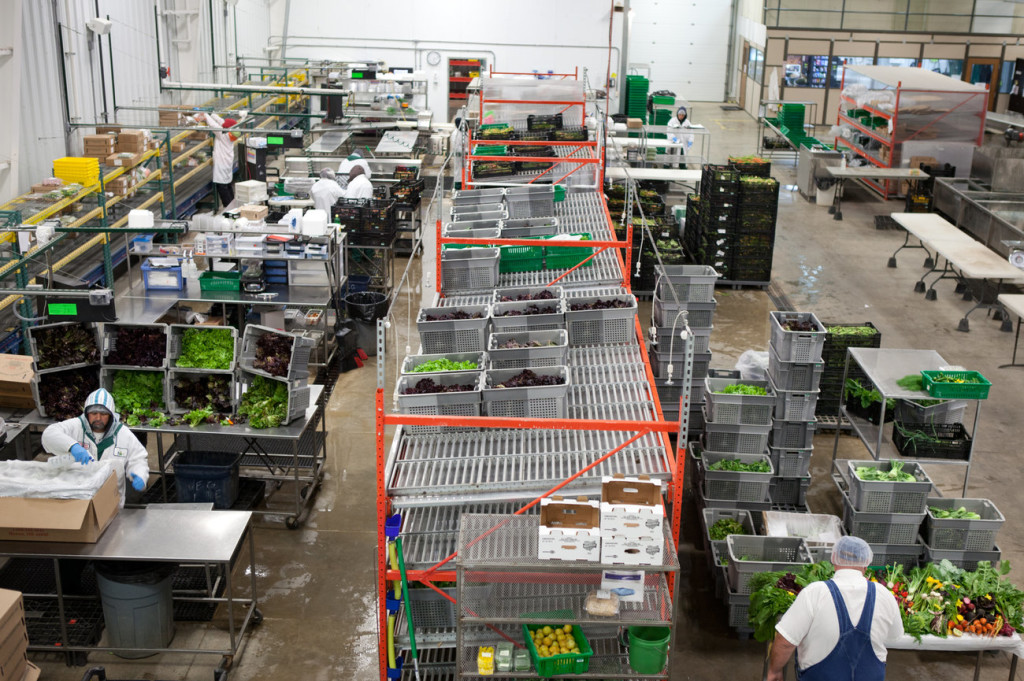 Ryan Kellman/NPR
Ryan Kellman/NPR
When you see the photo of their farm's packing facility, you probably just see a big warehouse of veggies. I see a great deal of inspiration for the future of JBG in the details. I see a refrigerated room for sorting and packing, keeping the cold chain intact and the produce at its freshest. I see that there is good flow, easy movement, and great placement of tables and machines for the tasks at hand. I see drains on the floors and stainless steel surfaces and ten other things that guarantee the highest level of food safety in their facility. These are all plans for our future JBG facility and it's encouraging to see these farmers doing it. It's a result of that same dedication to constant improvement. We would be bored without the challenge!






 0 ITEMS IN CART
0 ITEMS IN CART 
